Inbox and Environment News: Issue 328
September 3 - 9, 2017: Issue 328
Film Screening: 'Coal- Is It Worth It?'
Friday, September 15 at 6:30 PM - 8:30 PM
Avalon Public SchoolOld Barrenjoey Rd, AvalonHosted by The Green Team
 The film is a new documentary by veteran filmmaker and Pittwater resident, John Davis who tragically died in a helicopter crash while trying to expose damage caused by the Shenua coal-mine. His family and friends completed the film in his memory.
The film is a new documentary by veteran filmmaker and Pittwater resident, John Davis who tragically died in a helicopter crash while trying to expose damage caused by the Shenua coal-mine. His family and friends completed the film in his memory.
The film shows the effect on the land and the air we breathe. It depicts invasive coal expansion near our farms and forests. It also documents some of the inspirational people who have dedicated their lives to stopping this destruction of our environment. Some of the best experts in the field of climate change give us hope and knowledge to save the climate for future generations.
Tickets are $5 and can be purchased at the door on the night. The ticket cost goes towards the making of the film. FREE POPCORN will also be available on the night!
Please come along and support one of our local families!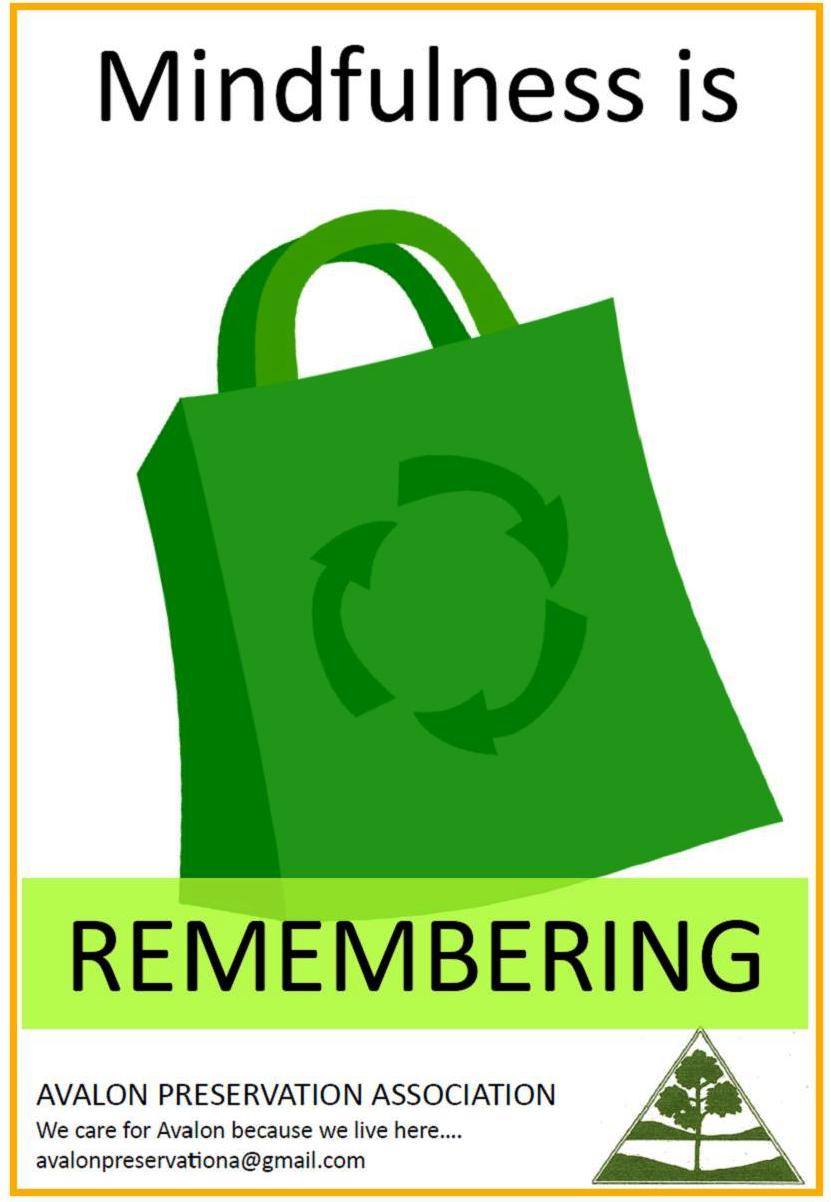
Friday, September 15 at 6:30 PM - 8:30 PM
Avalon Public School
Old Barrenjoey Rd, Avalon
Hosted by The Green Team
 The film is a new documentary by veteran filmmaker and Pittwater resident, John Davis who tragically died in a helicopter crash while trying to expose damage caused by the Shenua coal-mine. His family and friends completed the film in his memory.
The film is a new documentary by veteran filmmaker and Pittwater resident, John Davis who tragically died in a helicopter crash while trying to expose damage caused by the Shenua coal-mine. His family and friends completed the film in his memory. The film shows the effect on the land and the air we breathe. It depicts invasive coal expansion near our farms and forests. It also documents some of the inspirational people who have dedicated their lives to stopping this destruction of our environment. Some of the best experts in the field of climate change give us hope and knowledge to save the climate for future generations.
Tickets are $5 and can be purchased at the door on the night. The ticket cost goes towards the making of the film. FREE POPCORN will also be available on the night!
Please come along and support one of our local families!

Mona Vale Garden Club Spring Show 2017
SATURDAY 23 SEPTEMBER, 2017:10.30am to 4pmTed Blackwood Hall
WarriewoodThe Mona Vale Garden Club are holding their 46th annual Spring Show at the Ted Blackwood Hall, Cnr. Jacksons & Boondah Road, Warriewood. Open from 10.30am to 4pm. Adults $2 entry. The Show will feature flowers, vegetable displays, herbs, floral art and a childrens’ section. Items for sale will include the a great Plants stall, the ever-popular White Elephant stall, craft & cakes etc. Light refreshments also available. Profits from the day go to the Mona Vale Hospital Auxilliary. For more information please contact Tel 0402 655 811.
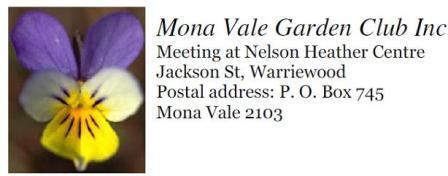
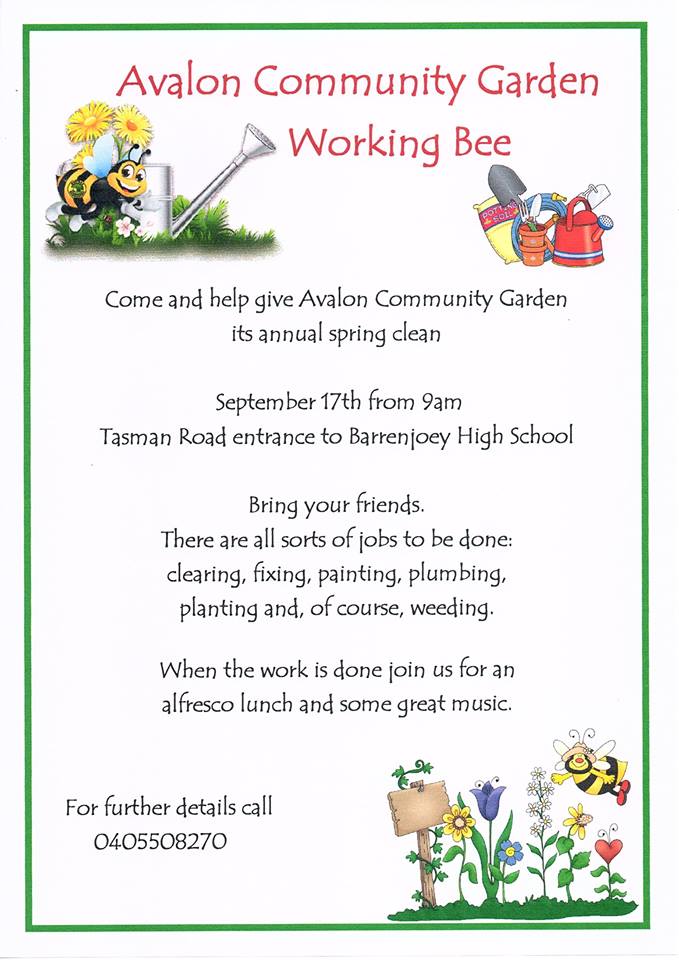
SATURDAY 23 SEPTEMBER, 2017:10.30am to 4pm
Ted Blackwood Hall
Warriewood
The Mona Vale Garden Club are holding their 46th annual Spring Show at the Ted Blackwood Hall, Cnr. Jacksons & Boondah Road, Warriewood.
Open from 10.30am to 4pm.
Adults $2 entry.
The Show will feature flowers, vegetable displays, herbs, floral art and a childrens’ section. Items for sale will include the a great Plants stall, the ever-popular White Elephant stall, craft & cakes etc.
Light refreshments also available.
Profits from the day go to the Mona Vale Hospital Auxilliary.
For more information please contact Tel 0402 655 811.


PNHA Birdwatching
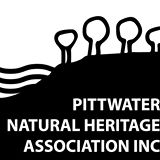 8am Sun 17 September, Irrawong ReserveCelebrate the arrival of Spring with a PNHA bird walk starting at the rainforest at Irrawong Reserve, home to Superb Lyrebirds, White-throated Treecreepers and the occasional Powerful Owl.
8am Sun 17 September, Irrawong ReserveCelebrate the arrival of Spring with a PNHA bird walk starting at the rainforest at Irrawong Reserve, home to Superb Lyrebirds, White-throated Treecreepers and the occasional Powerful Owl.
8-10am approx. Meet at the end of Irrawong Rd, Nth Narrabeen.Bring binoculars, water, insect repellent, morning tea if you wish. Families welcome. Bookings aren't essential. Enquiries to pnhabirdwatching@gmail.com
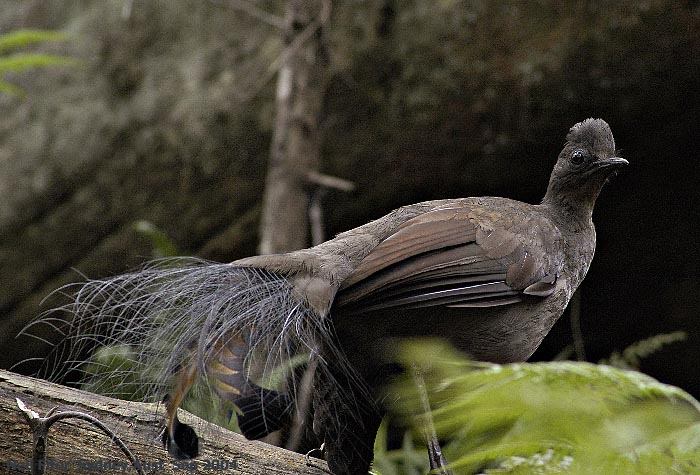
Photo of Superb Lyrebird by Neil Fifer.Bushcare in Pittwater
For further information or to confirm the meeting details for below groups, please contact Council's Bushcare Officer on 9970 1367
BUSHCARE SCHEDULES
Where we work Which day What time
Avalon
Angophora Reserve 3rd Sunday 8:30 - 11:30am
Avalon Dunes 1st Sunday 8:30 - 11:30am
Avalon Golf Course 2nd Wednesday 3 - 5:30pm
Careel Creek 4th Saturday 8:30 - 11:30am
Toongari Reserve 3rd Saturday 9 - 12noon (8 - 11am in summer)
Bangalley Headland 2nd Sunday 9 to 12noon
Bayview
Winnererremy Bay 4th Sunday 9 to 12noon
Bilgola
North Bilgola Beach 3rd Monday 9 - 12noon
Algona Reserve 1st Saturday 9 - 12noon
Plateau Park 1st Friday 8:30 - 11:30am
Church Point
Browns Bay Reserve 1st Tuesday 9 - 12noon
McCarrs Creek Reserve Contact Bushcare Officer To be confirmed
Clareville
Old Wharf Reserve 3rd Saturday 8 - 11am
Elanora
Kundibah Reserve 4th Sunday 8:30 - 11:30am
Mona Vale
Mona Vale Beach Basin 1st Saturday 8 - 11am
Mona Vale Dunes 2nd Saturday+3rd Thursday 8:30 - 11:30am
Newport
Bungan Beach 4th Sunday 9 - 12noon
Crescent Reserve 3rd Sunday 9 - 12noon
North Newport Beach 4th Saturday 8:30 - 11:30am
Porter Reserve 2nd Saturday 8 - 11am
North Narrabeen
Irrawong Reserve 3rd Saturday 2 - 5pm
Palm Beach
North Palm Beach Dunes 3rd Saturday 9 - 12noon
Scotland Island
Catherine Park 2nd Sunday 10 - 12:30pm
Elizabeth Park 1st Saturday 9 - 12noon
Pathilda Reserve 3rd Saturday 9 - 12noon
Warriewood
Warriewood Wetlands 1st Sunday 8:30 - 11:30am
Whale Beach
Norma Park 1st Friday 9 - 12noon
Western Foreshores
Coopers Point, Elvina Bay 2nd Sunday 10 - 1pm
Rocky Point, Elvina Bay 1st Monday 9 - 12noon
 8am Sun 17 September,
8am Sun 17 September, Irrawong Reserve
Celebrate the arrival of Spring with a PNHA bird walk starting at the rainforest at Irrawong Reserve, home to Superb Lyrebirds, White-throated Treecreepers and the occasional Powerful Owl.
8-10am approx.
Meet at the end of Irrawong Rd, Nth Narrabeen.
Bring binoculars, water, insect repellent, morning tea if you wish. Families welcome. Bookings aren't essential.
Enquiries to pnhabirdwatching@gmail.com

Photo of Superb Lyrebird by Neil Fifer.
Bushcare in Pittwater
For further information or to confirm the meeting details for below groups, please contact Council's Bushcare Officer on 9970 1367
BUSHCARE SCHEDULES
Where we work Which day What time
Avalon
Angophora Reserve 3rd Sunday 8:30 - 11:30am
Avalon Dunes 1st Sunday 8:30 - 11:30am
Avalon Golf Course 2nd Wednesday 3 - 5:30pm
Careel Creek 4th Saturday 8:30 - 11:30am
Toongari Reserve 3rd Saturday 9 - 12noon (8 - 11am in summer)
Bangalley Headland 2nd Sunday 9 to 12noon
Bayview
Winnererremy Bay 4th Sunday 9 to 12noon
Bilgola
North Bilgola Beach 3rd Monday 9 - 12noon
Algona Reserve 1st Saturday 9 - 12noon
Plateau Park 1st Friday 8:30 - 11:30am
Church Point
Browns Bay Reserve 1st Tuesday 9 - 12noon
McCarrs Creek Reserve Contact Bushcare Officer To be confirmed
Clareville
Old Wharf Reserve 3rd Saturday 8 - 11am
Elanora
Kundibah Reserve 4th Sunday 8:30 - 11:30am
Mona Vale
Mona Vale Beach Basin 1st Saturday 8 - 11am
Mona Vale Dunes 2nd Saturday+3rd Thursday 8:30 - 11:30am
Newport
Bungan Beach 4th Sunday 9 - 12noon
Crescent Reserve 3rd Sunday 9 - 12noon
North Newport Beach 4th Saturday 8:30 - 11:30am
Porter Reserve 2nd Saturday 8 - 11am
North Narrabeen
Irrawong Reserve 3rd Saturday 2 - 5pm
Palm Beach
North Palm Beach Dunes 3rd Saturday 9 - 12noon
Scotland Island
Catherine Park 2nd Sunday 10 - 12:30pm
Elizabeth Park 1st Saturday 9 - 12noon
Pathilda Reserve 3rd Saturday 9 - 12noon
Warriewood
Warriewood Wetlands 1st Sunday 8:30 - 11:30am
Whale Beach
Norma Park 1st Friday 9 - 12noon
Western Foreshores
Coopers Point, Elvina Bay 2nd Sunday 10 - 1pm
Rocky Point, Elvina Bay 1st Monday 9 - 12noon
Where we work Which day What time
Avalon
Angophora Reserve 3rd Sunday 8:30 - 11:30am
Avalon Dunes 1st Sunday 8:30 - 11:30am
Avalon Golf Course 2nd Wednesday 3 - 5:30pm
Careel Creek 4th Saturday 8:30 - 11:30am
Toongari Reserve 3rd Saturday 9 - 12noon (8 - 11am in summer)
Bangalley Headland 2nd Sunday 9 to 12noon
Bayview
Winnererremy Bay 4th Sunday 9 to 12noon
Bilgola
North Bilgola Beach 3rd Monday 9 - 12noon
Algona Reserve 1st Saturday 9 - 12noon
Plateau Park 1st Friday 8:30 - 11:30am
Church Point
Browns Bay Reserve 1st Tuesday 9 - 12noon
McCarrs Creek Reserve Contact Bushcare Officer To be confirmed
Clareville
Old Wharf Reserve 3rd Saturday 8 - 11am
Elanora
Kundibah Reserve 4th Sunday 8:30 - 11:30am
Mona Vale
Mona Vale Beach Basin 1st Saturday 8 - 11am
Mona Vale Dunes 2nd Saturday+3rd Thursday 8:30 - 11:30am
Newport
Bungan Beach 4th Sunday 9 - 12noon
Crescent Reserve 3rd Sunday 9 - 12noon
North Newport Beach 4th Saturday 8:30 - 11:30am
Porter Reserve 2nd Saturday 8 - 11am
North Narrabeen
Irrawong Reserve 3rd Saturday 2 - 5pm
Palm Beach
North Palm Beach Dunes 3rd Saturday 9 - 12noon
Scotland Island
Catherine Park 2nd Sunday 10 - 12:30pm
Elizabeth Park 1st Saturday 9 - 12noon
Pathilda Reserve 3rd Saturday 9 - 12noon
Warriewood
Warriewood Wetlands 1st Sunday 8:30 - 11:30am
Whale Beach
Norma Park 1st Friday 9 - 12noon
Western Foreshores
Coopers Point, Elvina Bay 2nd Sunday 10 - 1pm
Rocky Point, Elvina Bay 1st Monday 9 - 12noon
Free Guided Bush Walk
Dundundra Falls Reserve, Terrey Hills.10th September 10 -12 pm at Myoora end of Larool Road Fire Trail Terrey HillsCome down and enjoy the wild flowers and have all your questions answered by our qualified bush consultant.
This reserve is exploding with colour at the moment so even if you can’t make this special walk you can come down anytime and enjoy our new map and information signs and appreciate what this 40 Hectare recreational Reserve is all about.
Wear clothes and shoes suitable for bush walking and be prepared for Ticks and Leeches as unfortunately they like living here too.
Questions to dundundrafalls@gmail.com
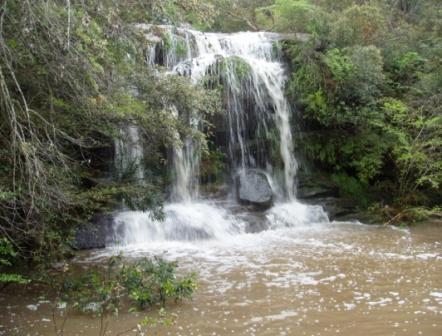
Dundundra Falls Reserve, Terrey Hills.
10th September 10 -12 pm at Myoora end of Larool Road Fire Trail Terrey Hills
Come down and enjoy the wild flowers and have all your questions answered by our qualified bush consultant.
This reserve is exploding with colour at the moment so even if you can’t make this special walk you can come down anytime and enjoy our new map and information signs and appreciate what this 40 Hectare recreational Reserve is all about.
Wear clothes and shoes suitable for bush walking and be prepared for Ticks and Leeches as unfortunately they like living here too.
Questions to dundundrafalls@gmail.com

Long Reef Walks 2017/18 Season
If you’d like to join us on a walk please contact me a couple of weeks before the walk date to make a booking. FREE GUIDED WALKS of Long Reef Aquatic Reserve with NSW Department of Industry & Investment Fishcare Volunteers will be held on the following date:
Dates for 2017Sunday 17 September 2017 11:00am – 1:00pmSunday 8 October 2017 3:30pm – 5:30pmSunday 5 November 2017 3:00pm – 5:00pmSunday 3 December 2017 2:00pm – 4:00pm
Dates for 2018Sunday 14 January 2018 1:00pm – 3:00pmSunday 18 February 2018 4:00pm – 6:00pmSunday 18 March 2018 3:00pm – 5:00pmSunday 15 April 2018 1:00pm – 3:00pm
~ Walks are held subject to weather conditions ~
Bookings are preferred.Please email Wendy to book: longreefwalks@gmail.com
Phil Colman, who keeps us updated on the Fishcare Volunteer Walks, has said, when sending in these monthly dates for the new season walks;
"I am only too happy to take individuals or small groups of senior school students out when I might be able to help them with their studies, give them possible projects or whatever.
Keep in mind that I am totally dictated to by tides, but am retired and basically available at any time. I am not, by the way, looking for payment. If I can steer someone in the direction of marine study, I’m paid enough!"
You contact Phil via email at: phil@easy.com.au - ph; 9982 6142
If you’d like to join us on a walk please contact me a couple of weeks before the walk date to make a booking. FREE GUIDED WALKS of Long Reef Aquatic Reserve with NSW Department of Industry & Investment Fishcare Volunteers will be held on the following date:
Dates for 2017
Sunday 17 September 2017 11:00am – 1:00pm
Sunday 8 October 2017 3:30pm – 5:30pm
Sunday 5 November 2017 3:00pm – 5:00pm
Sunday 3 December 2017 2:00pm – 4:00pm
Dates for 2018
Sunday 14 January 2018 1:00pm – 3:00pm
Sunday 18 February 2018 4:00pm – 6:00pm
Sunday 18 March 2018 3:00pm – 5:00pm
Sunday 15 April 2018 1:00pm – 3:00pm
~ Walks are held subject to weather conditions ~
Bookings are preferred.
Please email Wendy to book: longreefwalks@gmail.com
Phil Colman, who keeps us updated on the Fishcare Volunteer Walks, has said, when sending in these monthly dates for the new season walks;
"I am only too happy to take individuals or small groups of senior school students out when I might be able to help them with their studies, give them possible projects or whatever.
Keep in mind that I am totally dictated to by tides, but am retired and basically available at any time. I am not, by the way, looking for payment. If I can steer someone in the direction of marine study, I’m paid enough!"
You contact Phil via email at: phil@easy.com.au - ph; 9982 6142
Navigation Warning - NSW Coastal Waters: Whale Migration Season
NSW COASTAL WATERS2017 WHALE MIGRATION SEASONJune to December 2017
DESCRIPTIONMigrating whales and whale calves are expected to be present in numbers off the NSW coast during this time.
From June to August whales will be in greater abundance generally moving north within about five nautical miles (nine kilometres) of the coast.
From August to December whales will be in greater abundance generally moving south within about 10-15 nautical miles (18-28 kilometres) of the coast.
From July to December Southern Right Whales with calves are likely to be present within 10 nautical miles of the NSW coast and within coastal estuaries.
DIRECTIONWithin this period it is expected that whale sightings may be common and mariners are advised to navigate with due care and appropriate caution around any whale activity, including reducing to an appropriate speed to maintain safe navigation.
The approach distance for whales in NSW and Commonwealth waters is 100 metres for whales without calves. If calves are present the approach distance is 300 metres.
In the event of a collision with a whale, entanglement or whale carcass sighting please call:
National Parks and Wildlife Service Incident Duty Officer on: 02 9895 6444
MAP & CHARTS AFFECTEDCharts: AUS 806 to AUS 813 Inclusive.
RMS Coastal Boating Maps: 1-14 Inclusive.
Contact Details:
For further details please contact the National Parks and Wildlife Service, Wildlife Team on 9585 6523 or (RMS Contact details 13 12 36)
Information regarding the current location of whales may be obtained at:http://www.wildaboutwhales.com.au/
Further information about whale approach distances or whale behaviour may be obtained from the Office of Environment and Heritage website at: http://www.environment.nsw.gov.au/
MARINE NOTICE SY1724
NSW COASTAL WATERS
2017 WHALE MIGRATION SEASON
June to December 2017
DESCRIPTION
Migrating whales and whale calves are expected to be present in numbers off the NSW coast during this time.
From June to August whales will be in greater abundance generally moving north within about five nautical miles (nine kilometres) of the coast.
From August to December whales will be in greater abundance generally moving south within about 10-15 nautical miles (18-28 kilometres) of the coast.
From July to December Southern Right Whales with calves are likely to be present within 10 nautical miles of the NSW coast and within coastal estuaries.
DIRECTION
Within this period it is expected that whale sightings may be common and mariners are advised to navigate with due care and appropriate caution around any whale activity, including reducing to an appropriate speed to maintain safe navigation.
The approach distance for whales in NSW and Commonwealth waters is 100 metres for whales without calves. If calves are present the approach distance is 300 metres.
In the event of a collision with a whale, entanglement or whale carcass sighting please call:
National Parks and Wildlife Service Incident Duty Officer on: 02 9895 6444
MAP & CHARTS AFFECTED
Charts: AUS 806 to AUS 813 Inclusive.
RMS Coastal Boating Maps: 1-14 Inclusive.
Contact Details:
For further details please contact the National Parks and Wildlife Service, Wildlife Team on 9585 6523 or (RMS Contact details 13 12 36)
Information regarding the current location of whales may be obtained at:http://www.wildaboutwhales.com.au/
Further information about whale approach distances or whale behaviour may be obtained from the Office of Environment and Heritage website at: http://www.environment.nsw.gov.au/
MARINE NOTICE SY1724
Threatened Species Day September 7th 2017
23 August 2017: NSW OE&HNational Threatened Species Day is commemorated across the country on 7 September to raise awareness of plants and animals at risk of extinction.Australia is home to more than 500,000 animal and plant species, many of which are found nowhere else in the world. Over the last 200 years, more than 100 animal and plant species have become extinct.
In NSW alone there are close to 1000 animal and plant species at risk of extinction.
Threatened Species Day is when we turn the spotlight on native plants, animals, and ecosystems that are under threat and reflect on how we can protect them into the future.
The day also celebrates the amazing work that is being done to save them by passionate conservationists, researchers, volunteers, and community experts.
Threatened Species Day events and activitiesFind out what is happening near you or what you can do to get involved forNational Threatened Species Day, 7 September 2017.
How to host a Threatened Species Day eventOur guide has advice and resources for running a successful Threatened Species Day event in your business, school or community.
How is Saving our Species helpingWatch videos about some of the recent Saving our Species projects and how they are helping NSW threatened plants and animals.
About Threatened Species DayThreatened Species Day was declared in 1996 to commemorate the 60th anniversary of the death of the last remaining Tasmanian tiger (also known as the thylacine) at Hobart Zoo in 1936.
Threatened Species Day is a time to reflect on what happened in the past and how similar fates to the thylacine could await other native plants and animals unless appropriate action is taken.
Watch film clips of thylacines in captivity that include the last film footage of the species.
Why are threatened species important?Saving threatened species is important for a healthy and diverse environment. Once plants and animals become extinct they are gone forever.
Today most species become threatened because of habitat destruction and the invasion of non-native species. With effective management almost all threatened species can be protected.
Why promote threatened species?Helping people understand the problems that cause plants and animals to become extinct can help us to effectively manage threatened species in NSW. Being aware of how our actions can increase the risk of species loss and curbing these activities will support conservation efforts to prevent species becoming extinct in the wild.
We encourage everyone, whether you are a scientist, an artist, a business person, a sportsperson, an educator, work for local government or just love plants and animals, to do something to celebrate National Threatened Species Day and our unique threatened wildlife.
How can you help?No matter what your background, age or expertise, you can get involved with conservation programs and help the recovery of threatened animals and plants.
23 August 2017: NSW OE&H
National Threatened Species Day is commemorated across the country on 7 September to raise awareness of plants and animals at risk of extinction.
Australia is home to more than 500,000 animal and plant species, many of which are found nowhere else in the world. Over the last 200 years, more than 100 animal and plant species have become extinct.
In NSW alone there are close to 1000 animal and plant species at risk of extinction.
Threatened Species Day is when we turn the spotlight on native plants, animals, and ecosystems that are under threat and reflect on how we can protect them into the future.
The day also celebrates the amazing work that is being done to save them by passionate conservationists, researchers, volunteers, and community experts.
Threatened Species Day events and activities
Find out what is happening near you or what you can do to get involved forNational Threatened Species Day, 7 September 2017.
How to host a Threatened Species Day event
Our guide has advice and resources for running a successful Threatened Species Day event in your business, school or community.
How is Saving our Species helping
Watch videos about some of the recent Saving our Species projects and how they are helping NSW threatened plants and animals.
About Threatened Species Day
Threatened Species Day was declared in 1996 to commemorate the 60th anniversary of the death of the last remaining Tasmanian tiger (also known as the thylacine) at Hobart Zoo in 1936.
Threatened Species Day is a time to reflect on what happened in the past and how similar fates to the thylacine could await other native plants and animals unless appropriate action is taken.
Watch film clips of thylacines in captivity that include the last film footage of the species.
Why are threatened species important?
Saving threatened species is important for a healthy and diverse environment. Once plants and animals become extinct they are gone forever.
Today most species become threatened because of habitat destruction and the invasion of non-native species. With effective management almost all threatened species can be protected.
Why promote threatened species?
Helping people understand the problems that cause plants and animals to become extinct can help us to effectively manage threatened species in NSW. Being aware of how our actions can increase the risk of species loss and curbing these activities will support conservation efforts to prevent species becoming extinct in the wild.
We encourage everyone, whether you are a scientist, an artist, a business person, a sportsperson, an educator, work for local government or just love plants and animals, to do something to celebrate National Threatened Species Day and our unique threatened wildlife.
How can you help?
No matter what your background, age or expertise, you can get involved with conservation programs and help the recovery of threatened animals and plants.
$3 Million In Grants Now Available For Commuity Recycling Centres
Media release: EPAThe NSW Environment Protection Authority (EPA) and the NSW Environmental Trust (ET) are calling for local government, not-for-profit organisations and businesses from select Local Government areas to apply for grants to set up Community Recycling Centres (CRC) for the collection of household problem wastes.
The $3 million Community Recycling Centre grants program is now open as part of the Waste Less, Recycle More initiative. Community Recycling Centres make it easier for NSW residents to recycle or safely dispose items like oils, paints and batteries.
Applications are open until Wednesday 15 November 2017 with funding of up to $200,000 available to enhance existing facilities or build new facilities for the collection of problem waste. This is the fourth round of funding and it is designed to help keep problem waste out of the kerbside bin system by providing convenient and easy to use facilities for the community.
EPA Chair and CEO Barry Buffier said the aim of the program is to establish a network that will provide 90 per cent of NSW households with access to a free Community Recycling Centre for common household problem wastes.
“This funding focuses on our priority to establish Community Recycling Centres based on existing gaps in the network.
‘The funding to establish facilities in 22 priority Local Government Areas will mean residents will have a permanent facility available to people to drop-off low toxic wastes, such as gas bottles, household batteries, paint, oils and smoke detectors, Mr Buffier said.
‘To date, over 100 Community Recycling Centres have been funded in NSW and 62 are currently operational. Almost two million kilograms of household problem waste has been collected since the program started." Priority LGAs for funding include: Blacktown, Canterbury Bankstown, The Hills, Ku-ring-gai, Northern Beaches, Sydney, Bayside, Camden, Goulburn Mulwaree, North Sydney, Parramatta, Ryde, Shellharbour, Wagga Wagga, Waverley, Wollondilly, Woollahra, Yass Valley, Central Coast, Cumberland, Lake Macquarie and Sutherland. On behalf of the ET, Peter Dixon, Director Grants in the Office of Environment & Heritage states:
“This is one of our most successful community level grants programs. The take-up by local councils has been tremendous and the neighbourhoods with a new or upgraded Community Recycling Centre are enjoying the benefits of a free and convenient way of dropping off their problem wastes for environmentally friendly disposal and recycling”
Applications close 5pm, Wednesday 15 November 2017
For more information about the grants including how to apply and information sessions please visit:
For more information about Waste Less, Recycle More go to the EPA website:
Media release: EPA
The NSW Environment Protection Authority (EPA) and the NSW Environmental Trust (ET) are calling for local government, not-for-profit organisations and businesses from select Local Government areas to apply for grants to set up Community Recycling Centres (CRC) for the collection of household problem wastes.
The $3 million Community Recycling Centre grants program is now open as part of the Waste Less, Recycle More initiative. Community Recycling Centres make it easier for NSW residents to recycle or safely dispose items like oils, paints and batteries.
Applications are open until Wednesday 15 November 2017 with funding of up to $200,000 available to enhance existing facilities or build new facilities for the collection of problem waste.
This is the fourth round of funding and it is designed to help keep problem waste out of the kerbside bin system by providing convenient and easy to use facilities for the community.
EPA Chair and CEO Barry Buffier said the aim of the program is to establish a network that will provide 90 per cent of NSW households with access to a free Community Recycling Centre for common household problem wastes.
“This funding focuses on our priority to establish Community Recycling Centres based on existing gaps in the network.
‘The funding to establish facilities in 22 priority Local Government Areas will mean residents will have a permanent facility available to people to drop-off low toxic wastes, such as gas bottles, household batteries, paint, oils and smoke detectors, Mr Buffier said.
‘To date, over 100 Community Recycling Centres have been funded in NSW and 62 are currently operational. Almost two million kilograms of household problem waste has been collected since the program started."
Priority LGAs for funding include: Blacktown, Canterbury Bankstown, The Hills, Ku-ring-gai, Northern Beaches, Sydney, Bayside, Camden, Goulburn Mulwaree, North Sydney, Parramatta, Ryde, Shellharbour, Wagga Wagga, Waverley, Wollondilly, Woollahra, Yass Valley, Central Coast, Cumberland, Lake Macquarie and Sutherland.
On behalf of the ET, Peter Dixon, Director Grants in the Office of Environment & Heritage states:
“This is one of our most successful community level grants programs. The take-up by local councils has been tremendous and the neighbourhoods with a new or upgraded Community Recycling Centre are enjoying the benefits of a free and convenient way of dropping off their problem wastes for environmentally friendly disposal and recycling”
Applications close 5pm, Wednesday 15 November 2017
For more information about the grants including how to apply and information sessions please visit:
For more information about Waste Less, Recycle More go to the EPA website:
Asparagus Fern
Asparagus Fern is our worst weed in Pittwater. The Bush Invaders is by PNHA member and primary school teacher Sylvia Saszczak. Share to spread the message about this horror weed.

Asparagus Fern is our worst weed in Pittwater. The Bush Invaders is by PNHA member and primary school teacher Sylvia Saszczak. Share to spread the message about this horror weed.

Australian Bass And Estuary Perch Season Opens
30 August, 2017: NSW DPIThe three-month fishing closure for Australian Bass and Estuary Perch will draw to a close on Friday, allowing anglers to get back to targeting some of Australia’s great native sportsfish.
Department of Primary Industries (DPI) Senior Recreational Fisheries Manager, Cameron Westaway, said the annual zero bag limit for Australian Bass and Estuary Perch aims to protect these species during spawning.
“Over late autumn and early winter, Australian Bass and Estuary Perch form schools and migrate to parts of estuaries with the correct salinity, to trigger spawning,” Mr Westaway said.
“When they are in these large groups they can be vulnerable to fishing, so a zero bag limit applies to these fish from 1 June to 1 September each year.”Mr Westaway said the spawning period for Australian Bass and Estuary Perch is finished at the end of winter, with most returning to their spring and summer feeding ground higher up in the catchment.
“From 1 September, anglers can once again take these native species, however they are reminded that strict bag limits do apply,” Mr Westaway said.
“The total bag limit of two Australian Bass or Estuary Perch per person or a combination of both with a possession limit of four will be in place.
“Only one fish is permitted to be over 35 centimetres in length when fishing in rivers.”
Recreational fishers who are unsure of the fisheries rules should check before they go fishing.
Information on freshwater fishing rules can be found in the NSW Recreational Freshwater Fishing Guide from DPI Fisheries offices, at fishing licence agents and bait and tackle shops, and online atwww.dpi.nsw.gov.au/fishing.
Fishing laws are designed to protect, conserve and improve our fisheries resources for our future generations.
People can report suspected illegal fishing to the Fishers Watch Phoneline on 1800 043 536.
30 August, 2017: NSW DPI
The three-month fishing closure for Australian Bass and Estuary Perch will draw to a close on Friday, allowing anglers to get back to targeting some of Australia’s great native sportsfish.
Department of Primary Industries (DPI) Senior Recreational Fisheries Manager, Cameron Westaway, said the annual zero bag limit for Australian Bass and Estuary Perch aims to protect these species during spawning.
“Over late autumn and early winter, Australian Bass and Estuary Perch form schools and migrate to parts of estuaries with the correct salinity, to trigger spawning,” Mr Westaway said.
“When they are in these large groups they can be vulnerable to fishing, so a zero bag limit applies to these fish from 1 June to 1 September each year.”
Mr Westaway said the spawning period for Australian Bass and Estuary Perch is finished at the end of winter, with most returning to their spring and summer feeding ground higher up in the catchment.
“From 1 September, anglers can once again take these native species, however they are reminded that strict bag limits do apply,” Mr Westaway said.
“The total bag limit of two Australian Bass or Estuary Perch per person or a combination of both with a possession limit of four will be in place.
“Only one fish is permitted to be over 35 centimetres in length when fishing in rivers.”
Recreational fishers who are unsure of the fisheries rules should check before they go fishing.
Information on freshwater fishing rules can be found in the NSW Recreational Freshwater Fishing Guide from DPI Fisheries offices, at fishing licence agents and bait and tackle shops, and online atwww.dpi.nsw.gov.au/fishing.
Fishing laws are designed to protect, conserve and improve our fisheries resources for our future generations.
People can report suspected illegal fishing to the Fishers Watch Phoneline on 1800 043 536.
Mount Thorley Warkworth Mine Dam Wall Collapse: 50k Fine
Rio Tinto has been fined $50,000 over the collapse of a dam wall at its Mount Thorley Warkworth mine in 2016.
The company was prosecuted by the NSW Environment Protection Authority over the wall collapse, which allowed hundreds of thousands of litres of sediment-land water to escape from the dam and into surrounding areas.
Justice Moore found the harm resulting from the incident was "insubstantial", but the failure of the dam was both "foreseeable and preventable".
Environmentalists were dismayed with the verdict , slamming the penalty as woefully inadequate for a multi-national company that, earlier this month, posted a half-yearly profit of $4.1 billion.
“For the person on the street, this is roughly equivalent to getting fined a buck. One dollar. What kind of deterrent is that?” Steve Phillips, regional coordinator for Lock the Gate said.
“Mining companies in the Hunter must laugh when they get fines like this. But nobody else is laughing. We're disgusted.”
Justice Moore gave the company a $25,000 discount for its early guilty plea, but ordered it to pay the EPA's legal costs.
Full judgement may be read here
Rio Tinto has been fined $50,000 over the collapse of a dam wall at its Mount Thorley Warkworth mine in 2016.
The company was prosecuted by the NSW Environment Protection Authority over the wall collapse, which allowed hundreds of thousands of litres of sediment-land water to escape from the dam and into surrounding areas.
Justice Moore found the harm resulting from the incident was "insubstantial", but the failure of the dam was both "foreseeable and preventable".
Environmentalists were dismayed with the verdict , slamming the penalty as woefully inadequate for a multi-national company that, earlier this month, posted a half-yearly profit of $4.1 billion.
“For the person on the street, this is roughly equivalent to getting fined a buck. One dollar. What kind of deterrent is that?” Steve Phillips, regional coordinator for Lock the Gate said.
“Mining companies in the Hunter must laugh when they get fines like this. But nobody else is laughing. We're disgusted.”
Justice Moore gave the company a $25,000 discount for its early guilty plea, but ordered it to pay the EPA's legal costs.
Full judgement may be read here
HV Operations Fined For Polluting A Hunter Valley Creek
EPA Media release: 28 August 2017The Environment Protection Authority (EPA) has issued a $15,000 fine to HV Operations Pty Ltd for polluting Bayswater Creek in the Hunter Valley.
HV Operations self-reported the incident to the EPA’s Environment Line after a sediment sump discharged from its coal loading facilities into Bayswater Creek at Liddell on 30 March 2017.
It’s believed that the coal loading facility’s sediment sump overflowed resulting in 240 kilolitres of water containing sediment to runoff into the nearby waterway.
Mitchell Bennett, EPA’s Acting Director for the Hunter, said HV Operations had previously identified the sediment sump as a potential runoff risk and had obtained development approval to construct a larger sediment basin.
“The company had not put in place practical measures to mitigate discharge to water from the sediment sump in the period prior to commissioning of the sediment basin,” Mr Bennett said.
“As a result the EPA believes that the pollution to the creek could have been mitigated.
“There were opportunities for the company to install portable pumps and pipe lines to prevent overflow of the sediment sump to Bayswater Creek, but no contingencies had been put in place.”
The EPA requires pollution controls to be implemented at all times and that licensees comply with both their environment protection licence and the Protection of the Environment Operations Act 1997.
Any occupier of a premises covered by an Environment Protection Licence must identify pollution risks, put in place measures to mitigate these risks, whether short term or on a permanent basis.
Penalty notices are one of a number of tools the EPA can use to achieve environmental compliance including formal warnings, official cautions, licence conditions, notices and directions and prosecutions. For more information about the EPA’s regulatory tools, see the EPA Compliance Policy at http://www.epa.nsw.gov.au/legislation/prosguid.htm
EPA Media release: 28 August 2017
The Environment Protection Authority (EPA) has issued a $15,000 fine to HV Operations Pty Ltd for polluting Bayswater Creek in the Hunter Valley.
HV Operations self-reported the incident to the EPA’s Environment Line after a sediment sump discharged from its coal loading facilities into Bayswater Creek at Liddell on 30 March 2017.
It’s believed that the coal loading facility’s sediment sump overflowed resulting in 240 kilolitres of water containing sediment to runoff into the nearby waterway.
Mitchell Bennett, EPA’s Acting Director for the Hunter, said HV Operations had previously identified the sediment sump as a potential runoff risk and had obtained development approval to construct a larger sediment basin.
“The company had not put in place practical measures to mitigate discharge to water from the sediment sump in the period prior to commissioning of the sediment basin,” Mr Bennett said.
“As a result the EPA believes that the pollution to the creek could have been mitigated.
“There were opportunities for the company to install portable pumps and pipe lines to prevent overflow of the sediment sump to Bayswater Creek, but no contingencies had been put in place.”
The EPA requires pollution controls to be implemented at all times and that licensees comply with both their environment protection licence and the Protection of the Environment Operations Act 1997.
Any occupier of a premises covered by an Environment Protection Licence must identify pollution risks, put in place measures to mitigate these risks, whether short term or on a permanent basis.
Penalty notices are one of a number of tools the EPA can use to achieve environmental compliance including formal warnings, official cautions, licence conditions, notices and directions and prosecutions. For more information about the EPA’s regulatory tools, see the EPA Compliance Policy at http://www.epa.nsw.gov.au/legislation/prosguid.htm
Draft Plan To Improve Quality Of Water Flowing To The Great Barrier Reef
Joint media release: 30 August 2017 - The Hon. Josh Frydenberg MP, Minister for the Environment and Energy and The Hon. Steven Miles, Queensland Minister for Environment
The Australian and Queensland governments have today released the draft Reef 2050 Water Quality Improvement Plan 2017-2022 for consultation.
The renewed five-year plan details how industry, government and the community will continue to work together to improve the quality of water flowing to the Great Barrier Reef.
Minister for the Environment and Energy Josh Frydenberg said the draft plan was an update of the Reef Water Quality Protection Plan and supports delivery of the $2 billion Reef 2050 Long-Term Sustainability Plan.“By focusing our efforts on improving water quality, we are giving the Reef the best chance to adapt and recover from the impacts of coral bleaching,” Mr Frydenberg said.
“This new plan has an expanded scope and addresses all land-based sources of water pollution including run-off from urban, industrial and public lands, as well as from agricultural activities.
“Much has already been achieved by landholders and the community but more can be done to improve the land use practices of everyone living and working near the reef.”
Queensland Minister for the Environment Steven Miles said the plan recognised the importance of people in creating change and included social, cultural and economic values for the first time.
“The new plan sets water quality targets for each of the 35 catchments flowing to the Reef using scientific modelling and other technical information to work out the pollution reduction targets based on what the Reef needs to be healthy,” Mr Miles said.
“By setting these new targets at a catchment, region and whole-of-Reef scale, we can better prioritise our investment and effort.”
Mr Miles said a risk assessment was also undertaken to determine priority regions for reducing the run-off of nitrogen, pesticides and sediment.
“It is imperative that we continue to work in partnership to achieve the targets in this new plan. This will require governments at all levels to work together. It will also require land managers to take action, whether they be farmers, residents or industry.”
Interested organisations and people to provide their comments on the draft plan by 10 October 2017 via www.reefplan.qld.gov.au.
Joint media release: 30 August 2017 - The Hon. Josh Frydenberg MP, Minister for the Environment and Energy and The Hon. Steven Miles, Queensland Minister for Environment
The Australian and Queensland governments have today released the draft Reef 2050 Water Quality Improvement Plan 2017-2022 for consultation.
The renewed five-year plan details how industry, government and the community will continue to work together to improve the quality of water flowing to the Great Barrier Reef.
Minister for the Environment and Energy Josh Frydenberg said the draft plan was an update of the Reef Water Quality Protection Plan and supports delivery of the $2 billion Reef 2050 Long-Term Sustainability Plan.
“By focusing our efforts on improving water quality, we are giving the Reef the best chance to adapt and recover from the impacts of coral bleaching,” Mr Frydenberg said.
“This new plan has an expanded scope and addresses all land-based sources of water pollution including run-off from urban, industrial and public lands, as well as from agricultural activities.
“Much has already been achieved by landholders and the community but more can be done to improve the land use practices of everyone living and working near the reef.”
Queensland Minister for the Environment Steven Miles said the plan recognised the importance of people in creating change and included social, cultural and economic values for the first time.
“The new plan sets water quality targets for each of the 35 catchments flowing to the Reef using scientific modelling and other technical information to work out the pollution reduction targets based on what the Reef needs to be healthy,” Mr Miles said.
“By setting these new targets at a catchment, region and whole-of-Reef scale, we can better prioritise our investment and effort.”
Mr Miles said a risk assessment was also undertaken to determine priority regions for reducing the run-off of nitrogen, pesticides and sediment.
“It is imperative that we continue to work in partnership to achieve the targets in this new plan. This will require governments at all levels to work together. It will also require land managers to take action, whether they be farmers, residents or industry.”
Interested organisations and people to provide their comments on the draft plan by 10 October 2017 via www.reefplan.qld.gov.au.
Foundation Of Australia’s New Icebreaker Laid
August 25, 2017: Department of the Environment and Energy, Australian Antarctic Division
The first building block of Australia’s new icebreaker has been welded into place at a keel laying ceremony in Romania overnight.
Maritime tradition was observed with a 50 cent piece bearing Australia’s Coat of Arms, welded onto the keel by the Australian Antarctic Division’s Director, Dr Nick Gales.
“This marks the first major milestone in the construction of the 160 metre ship that will carry scientists and supplies to Antarctica for decades to come,” Dr Gales said.
“According to maritime tradition, attaching coins to the keel brings fair winds, speed and good luck.”
“We welded four coins to the keel, where they will remain as the ship crosses the Southern Ocean and cuts through the sea ice during its voyages to and from Antarctica.
Coins from Romania, Holland and Denmark sit alongside the Australian coin, from the Royal Australian Mint, in recognition of each countries contribution to the design and construction of the ship.
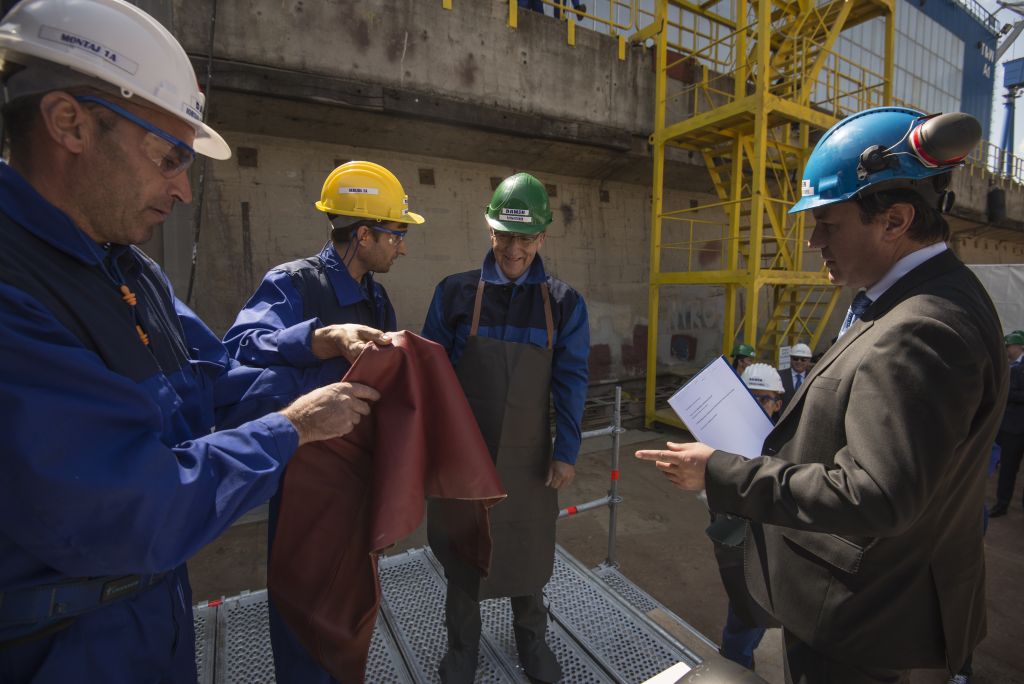
The Division's Director, Dr Nick Gales, prepares to uphold maritime tradition and weld four coins in place on the keel of the icebreaker. (Photo: Damen/Australian Antarctic Division)
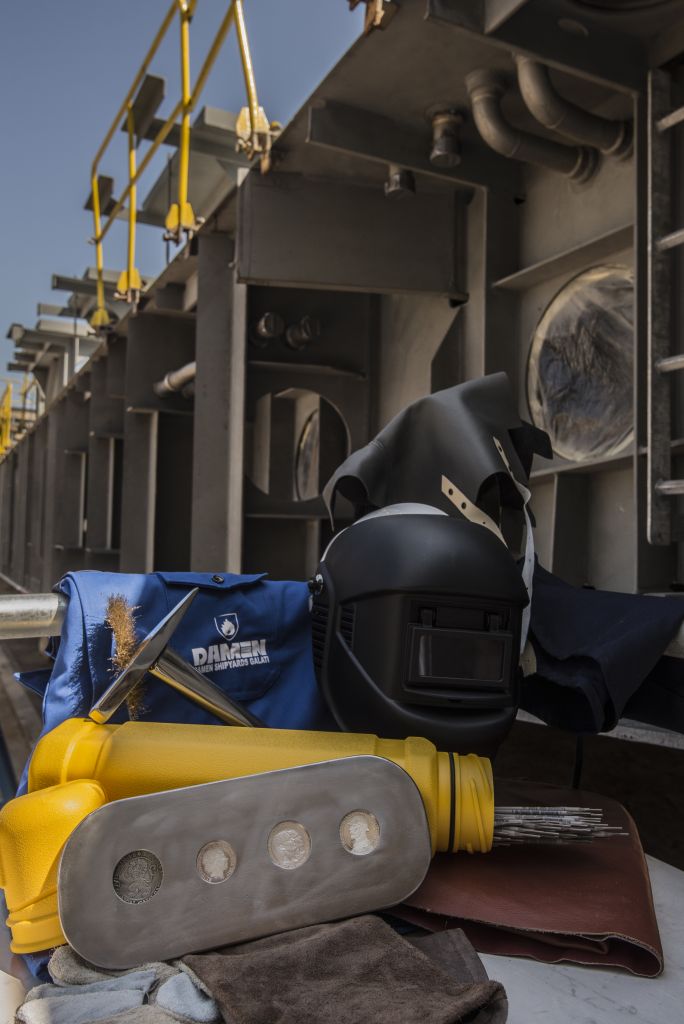
Four coins have been welded to the keel, where they will remain as the ship crosses the Southern Ocean and cuts through the sea ice during its voyages to and from Antarctica. (Photo: Damen/Australian Antarctic Division)
“The original concept was developed by a Danish company, the design and construction is being managed by a Dutch company and the icebreaker is being built in Romania,” Dr Gales said.
Duplicates of the coins will be placed on the bridge of the ship.
To date, over 3000 tonnes of steel has been cut, and construction has now moved into the dry dock where the keel was laid yesterday.
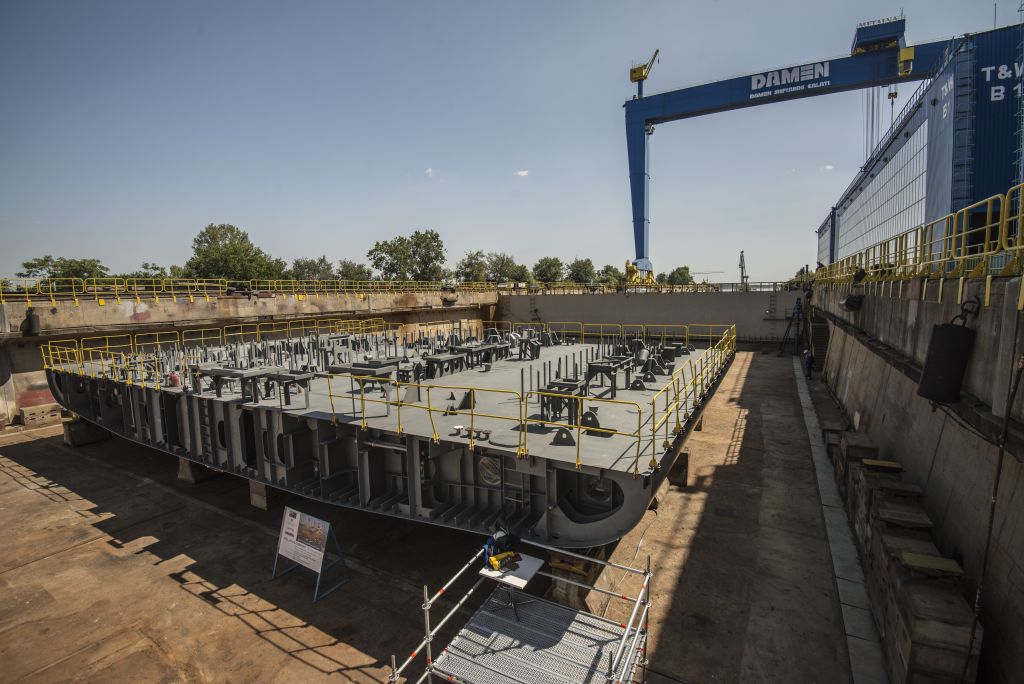
Over 3000 tonnes of steel has been cut to date. (Photo: Damen/Australian Antarctic Division)
Once the hull is complete, the dock will be filled with water and the ship floated out.
Australian school children were given the task of naming the sophisticated resupply and research vessel, with 792 classes putting forward a suggestion.
The winning name will be announced in the coming weeks and up to 12 students from the winning classes will be the first to fly to Antarctica and land on the icy continent.
The icebreaker will arrive in Hobart in 2020 and make its maiden voyage to Antarctica during the 2020/21 season.
August 25, 2017: Department of the Environment and Energy, Australian Antarctic Division
The first building block of Australia’s new icebreaker has been welded into place at a keel laying ceremony in Romania overnight.
Maritime tradition was observed with a 50 cent piece bearing Australia’s Coat of Arms, welded onto the keel by the Australian Antarctic Division’s Director, Dr Nick Gales.
“This marks the first major milestone in the construction of the 160 metre ship that will carry scientists and supplies to Antarctica for decades to come,” Dr Gales said.
“According to maritime tradition, attaching coins to the keel brings fair winds, speed and good luck.”
“We welded four coins to the keel, where they will remain as the ship crosses the Southern Ocean and cuts through the sea ice during its voyages to and from Antarctica.
Coins from Romania, Holland and Denmark sit alongside the Australian coin, from the Royal Australian Mint, in recognition of each countries contribution to the design and construction of the ship.

The Division's Director, Dr Nick Gales, prepares to uphold maritime tradition and weld four coins in place on the keel of the icebreaker. (Photo: Damen/Australian Antarctic Division)

Four coins have been welded to the keel, where they will remain as the ship crosses the Southern Ocean and cuts through the sea ice during its voyages to and from Antarctica. (Photo: Damen/Australian Antarctic Division)
“The original concept was developed by a Danish company, the design and construction is being managed by a Dutch company and the icebreaker is being built in Romania,” Dr Gales said.
Duplicates of the coins will be placed on the bridge of the ship.
To date, over 3000 tonnes of steel has been cut, and construction has now moved into the dry dock where the keel was laid yesterday.

Over 3000 tonnes of steel has been cut to date. (Photo: Damen/Australian Antarctic Division)
Once the hull is complete, the dock will be filled with water and the ship floated out.
Australian school children were given the task of naming the sophisticated resupply and research vessel, with 792 classes putting forward a suggestion.
The winning name will be announced in the coming weeks and up to 12 students from the winning classes will be the first to fly to Antarctica and land on the icy continent.
The icebreaker will arrive in Hobart in 2020 and make its maiden voyage to Antarctica during the 2020/21 season.
Conservation Dog Sniffs Signs Of Endangered Emu On The North Coast
August 30, 2017: OE&H - NPWS
A four-year-old springer spaniel detection dog called Penny is using her nose to detect coastal emu scent in a new monitoring program taking place across the Lower Clarence and Bungawalbin region ahead of Threatened Species Day (7 Sept).
These birds are part of an endangered population; the last of the emus that once roamed along much of the east coast of Australia.
Lynn Baker, Threatened Species Officer and Penny’s handler, said Penny is helping to search for coastal emus at four sites, using funding from the NSW Government’s Saving Our Species program.
“On a recent field trip, Penny located coastal emu scent, which was confirmed by fresh emu tracks and scats, and we could see that nearby vegetation had been foraged,” said Ms Baker.
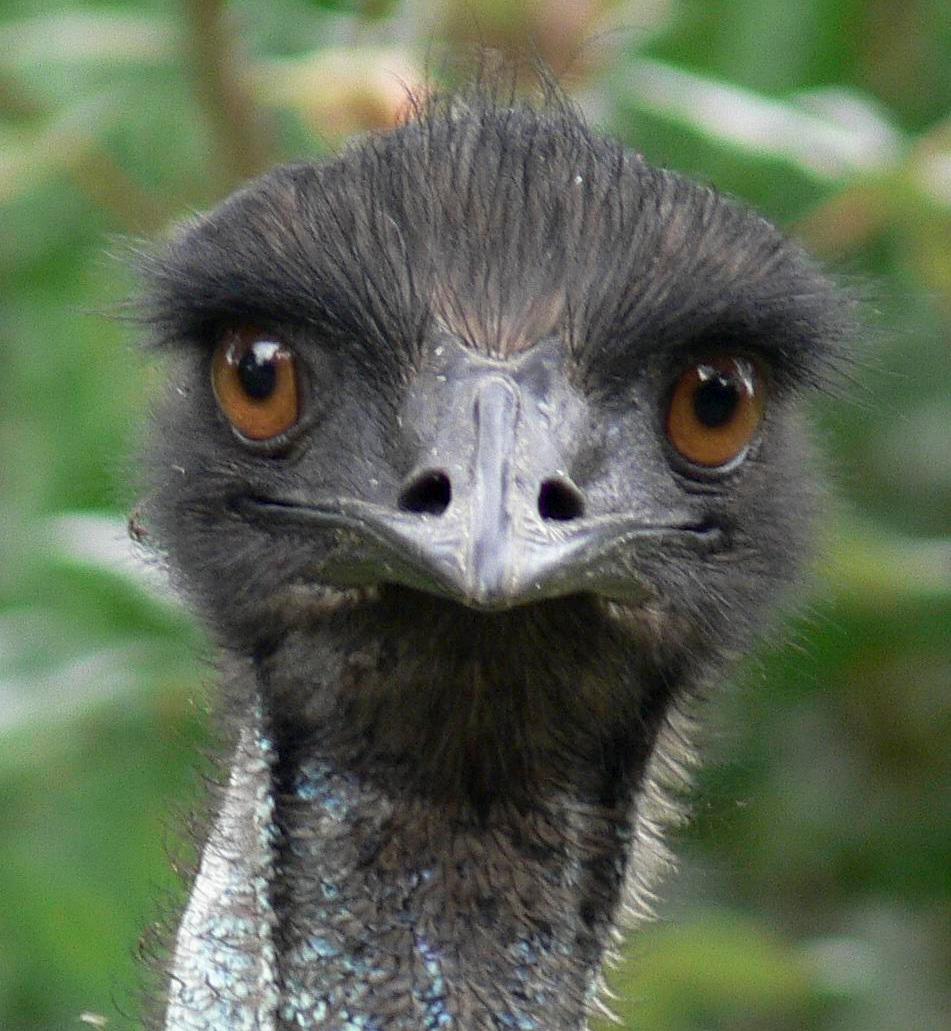
Coastal emu looking into camera, Lower Clarence - photo courtesy J.Turbill/OEH
“These are all positive signs that a coastal emu had recently been through the area.
“You would expect that a big bird like the coastal emu is easy to detect but this large, flightless bird is surprisingly elusive, which is why we need the specially trained nose of Penny.
“Penny is helping us to search for coastal emu nesting sites during the breeding season so that we can help keep the vulnerable ground nest sites and eggs safe.
“Given the rapidly declining numbers of this population, once we locate the nest sites we aim to set-up remote cameras to establish ongoing monitoring that will inform future management actions.
“It’s the male emu who has sole responsibility to sit on and incubate the eggs for 56 days; a risky task that exposes the emu, the eggs and eventually the chicks to many threats.
“Penny’s expertise is supported by a team conducting monthly field-trips to locate and monitor nest sites. The aim of the program is to find out more about breeding behaviour and importantly, egg and fledgling survival rates.
“Penny always gets an extra special treat after her successful field trips.
“We want to thank our program partners. The Coastal Emu Alliance and North Coast Local Land Services are providing remote cameras and private land holders are giving access to their land for the survey work,” said Ms Baker.
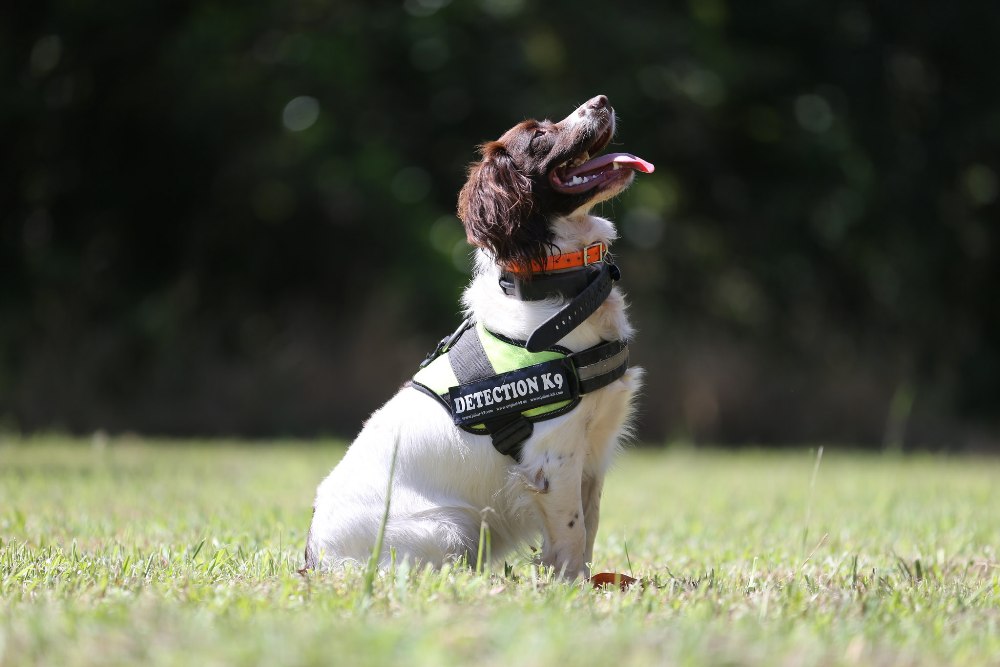
Detection dog Penny. Photo credit Jason O'Brien
Threatened Species Day is celebrated on the 7 September each year to raise awareness of plants and animals at risk of extinction and to highlight the work that is being done to save them.
The Coastal Emu monitoring program is part of the $100 million Saving our Species program which sets out the NSW Government’s threatened species management plan and what needs to be done to secure the State’s threatened species in the wild for the next 100 years.
Learn more about Saving our Species Program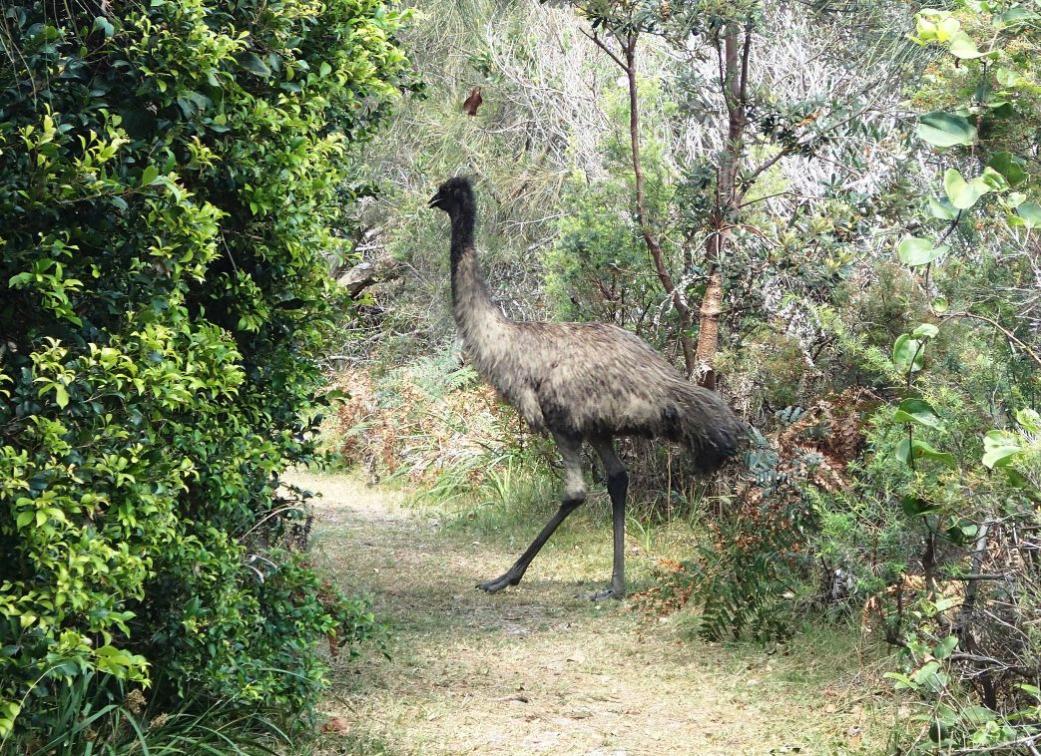 Coastal Emu on a track - Photo Credit Vicki Collins / OEH
Coastal Emu on a track - Photo Credit Vicki Collins / OEH
August 30, 2017: OE&H - NPWS
A four-year-old springer spaniel detection dog called Penny is using her nose to detect coastal emu scent in a new monitoring program taking place across the Lower Clarence and Bungawalbin region ahead of Threatened Species Day (7 Sept).
These birds are part of an endangered population; the last of the emus that once roamed along much of the east coast of Australia.
Lynn Baker, Threatened Species Officer and Penny’s handler, said Penny is helping to search for coastal emus at four sites, using funding from the NSW Government’s Saving Our Species program.
“On a recent field trip, Penny located coastal emu scent, which was confirmed by fresh emu tracks and scats, and we could see that nearby vegetation had been foraged,” said Ms Baker.

Coastal emu looking into camera, Lower Clarence - photo courtesy J.Turbill/OEH
“These are all positive signs that a coastal emu had recently been through the area.
“You would expect that a big bird like the coastal emu is easy to detect but this large, flightless bird is surprisingly elusive, which is why we need the specially trained nose of Penny.
“Penny is helping us to search for coastal emu nesting sites during the breeding season so that we can help keep the vulnerable ground nest sites and eggs safe.
“Given the rapidly declining numbers of this population, once we locate the nest sites we aim to set-up remote cameras to establish ongoing monitoring that will inform future management actions.
“It’s the male emu who has sole responsibility to sit on and incubate the eggs for 56 days; a risky task that exposes the emu, the eggs and eventually the chicks to many threats.
“Penny’s expertise is supported by a team conducting monthly field-trips to locate and monitor nest sites. The aim of the program is to find out more about breeding behaviour and importantly, egg and fledgling survival rates.
“Penny always gets an extra special treat after her successful field trips.
“We want to thank our program partners. The Coastal Emu Alliance and North Coast Local Land Services are providing remote cameras and private land holders are giving access to their land for the survey work,” said Ms Baker.

Detection dog Penny. Photo credit Jason O'Brien
Threatened Species Day is celebrated on the 7 September each year to raise awareness of plants and animals at risk of extinction and to highlight the work that is being done to save them.
The Coastal Emu monitoring program is part of the $100 million Saving our Species program which sets out the NSW Government’s threatened species management plan and what needs to be done to secure the State’s threatened species in the wild for the next 100 years.
Learn more about Saving our Species Program

Coastal Emu on a track - Photo Credit Vicki Collins / OEH
Shining A Light On Disaster Bay's Quolls
August 28, 2017: OE&H - NPWS
Remote cameras have spotted two elusive spotted-tailed quolls stalking the shadows of the Green Cape Light Station and the shores of Disaster Bay south of Eden.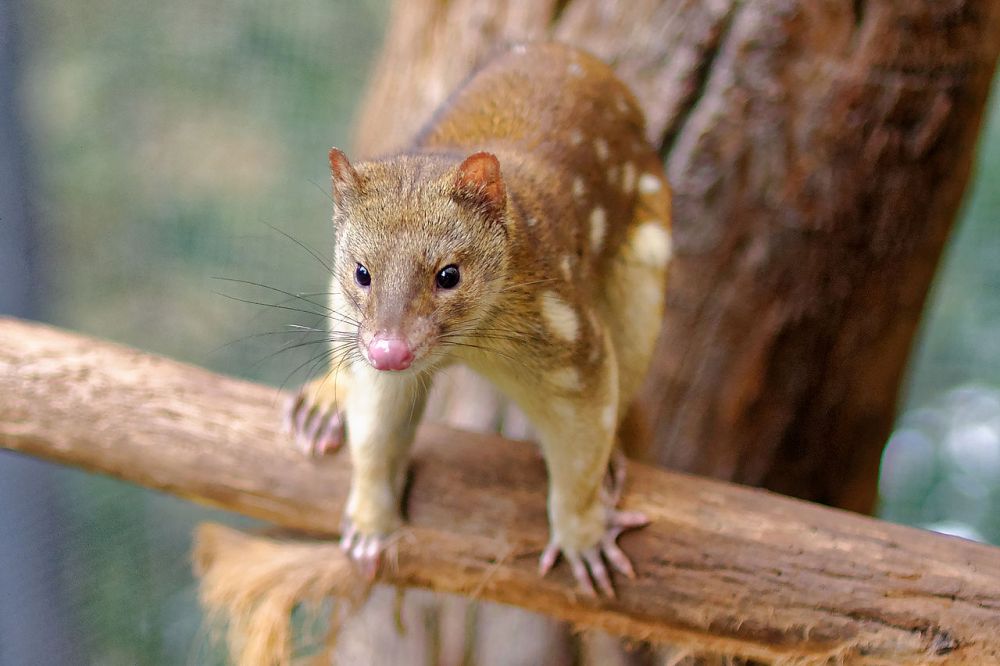
Spotted-tail Quoll (Dasyurus maculatus) - photo courtesy Michael J Fromholtz -Senior Research Scientist Dr Andrew Claridge said these curious creatures are two of only four quolls ever spotted on camera in Ben Boyd National Park in the past 10 years.
“Both quolls are male, appear to be around 2-3 years old and look very healthy,” said Dr Claridge.
“The first was captured lurking in the shadows of the light station around 2am and the second was caught on camera further up the road at Disaster Bay,” Dr Claridge said.
“The really big surprise is that this is our first ever record of the endangered Spotted-tailed Quoll in coastal heath in the region.
“The new images and the handful of other records over the past decade supports the notion that there could be a resident population of quolls right on the coast.
“Each Spotted-tailed quoll has a unique spot pattern or markings so it is relatively easy to distinguish individuals and in this case, we could be looking at close relatives.
“The quolls photographed were probably out hunting for mammals like ringtail possums, bandicoots, native mice and rats.
“During Winter female quolls are busy giving birth and raising pups, so males return to their bachelor ways and go back to roaming across the landscape,” Dr Claridge said.
The remote cameras that took these snaps form part of a long-term monitoring program by the National Parks and Wildlife Service to measure the response of native fauna to fox control in Ben Boyd National Park and Nadgee Nature Reserve.This program also contributes data to the Southern Brown Bandicoot and Long-nosed Potoroo Saving our Species projects.
“Seeing these two quolls literally pop their heads up when we were focussed on bandicoots and potoroos was a very unexpected but delightful surprise,” Dr Claridge said.
“It also reinforces that the local reserves are in great shape, affording habitat for an endangered marsupial carnivore.
“So far the cameras have only snapped male quolls which begs the question - where are all the females?
“We have found quoll tracks on nearby beaches that show prints from smaller quolls and juveniles which indicate that the females are around but remain camera-shy.
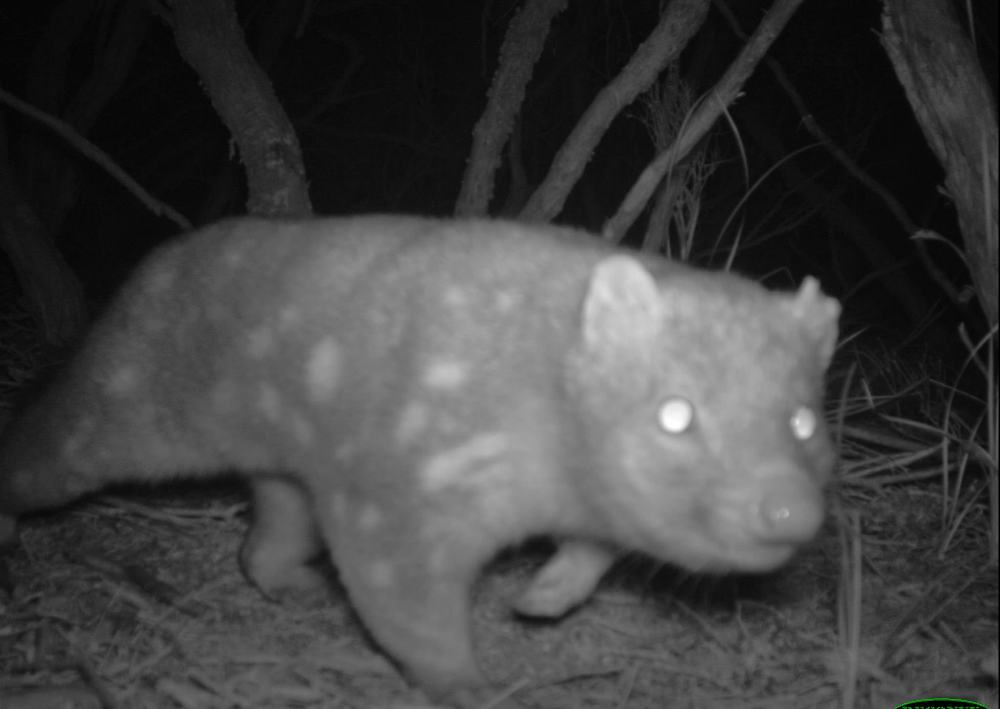
Quoll on the Light-to-Light walk - Ben Boyd NP - photo courtesy OE&H
For more information on Saving our Species projects, visit: Saving our Species Program.
August 28, 2017: OE&H - NPWS
Remote cameras have spotted two elusive spotted-tailed quolls stalking the shadows of the Green Cape Light Station and the shores of Disaster Bay south of Eden.

Spotted-tail Quoll (Dasyurus maculatus) - photo courtesy Michael J Fromholtz -
Senior Research Scientist Dr Andrew Claridge said these curious creatures are two of only four quolls ever spotted on camera in Ben Boyd National Park in the past 10 years.
“Both quolls are male, appear to be around 2-3 years old and look very healthy,” said Dr Claridge.
“The first was captured lurking in the shadows of the light station around 2am and the second was caught on camera further up the road at Disaster Bay,” Dr Claridge said.
“The really big surprise is that this is our first ever record of the endangered Spotted-tailed Quoll in coastal heath in the region.
“The new images and the handful of other records over the past decade supports the notion that there could be a resident population of quolls right on the coast.
“Each Spotted-tailed quoll has a unique spot pattern or markings so it is relatively easy to distinguish individuals and in this case, we could be looking at close relatives.
“The quolls photographed were probably out hunting for mammals like ringtail possums, bandicoots, native mice and rats.
“During Winter female quolls are busy giving birth and raising pups, so males return to their bachelor ways and go back to roaming across the landscape,” Dr Claridge said.
The remote cameras that took these snaps form part of a long-term monitoring program by the National Parks and Wildlife Service to measure the response of native fauna to fox control in Ben Boyd National Park and Nadgee Nature Reserve.
This program also contributes data to the Southern Brown Bandicoot and Long-nosed Potoroo Saving our Species projects.
“Seeing these two quolls literally pop their heads up when we were focussed on bandicoots and potoroos was a very unexpected but delightful surprise,” Dr Claridge said.
“It also reinforces that the local reserves are in great shape, affording habitat for an endangered marsupial carnivore.
“So far the cameras have only snapped male quolls which begs the question - where are all the females?
“We have found quoll tracks on nearby beaches that show prints from smaller quolls and juveniles which indicate that the females are around but remain camera-shy.

Quoll on the Light-to-Light walk - Ben Boyd NP - photo courtesy OE&H
For more information on Saving our Species projects, visit: Saving our Species Program.
Bloomin' Lovely! Endangered Grevillea Blooms Again
August 29, 2017: NPWS - OE&H
he critically endangered Wee Jasper Grevillea is flowering for the first time in 20 years in the Burrinjuck Nature Reserve after being protected by the NSW Government’s Saving our Species program.
Threatened Species Coordinator John Briggs said the thrill of seeing the plants at this site in full bloom is the exciting culmination of 30 years spent working to recover this species.
“The plant is only found in two places in the world, outside the town of Wee Jasper and on the slopes above Burrinjuck Dam,” said Mr Briggs.
“Unfortunately, this pretty cream-pink flowering shrub is a favourite food of feral goats and by the mid-1990s they had eaten all the plants at this site.
“As well as undertaking intensive feral goat control, we fenced the site to protect the few seedlings that emerged unscathed by the goats.
“We are now seeing firsthand how this work is paying off and last month observed the first flowers seen at this site in decades
“We paddled out to this remote site on the shores of Lake Burrinjuck and were greeted with small clusters of spider-like pink flowers nestled in among flourishing pointed green leaves.
“The plants will continue to flower in the coming months and over summer should start producing seed, hopefully resulting in even more recruitment at the site.
“Thanks to this fencing we counted around 150 seedlings that have established in recent years and we can’t wait to see these young adult plants mature and thus improve its chance of long term survival at the site,” Mr Briggs said.
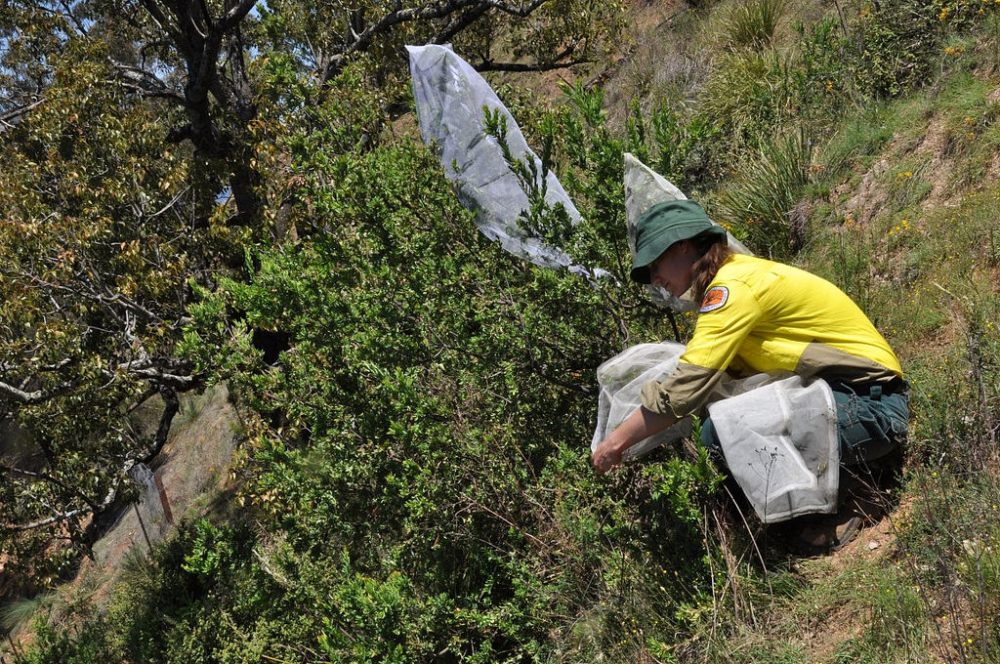
Wee Jasper Grevillea seed bags - photo courtesy OE&H
The Saving Our Species team and the NSW National Parks and Wildlife Service will continue to monitor these sites every three months, maintain the fencing and continue strategic pest management.
For more information on the NSW Government’s Saving our Species program, visit: Saving our Species Program.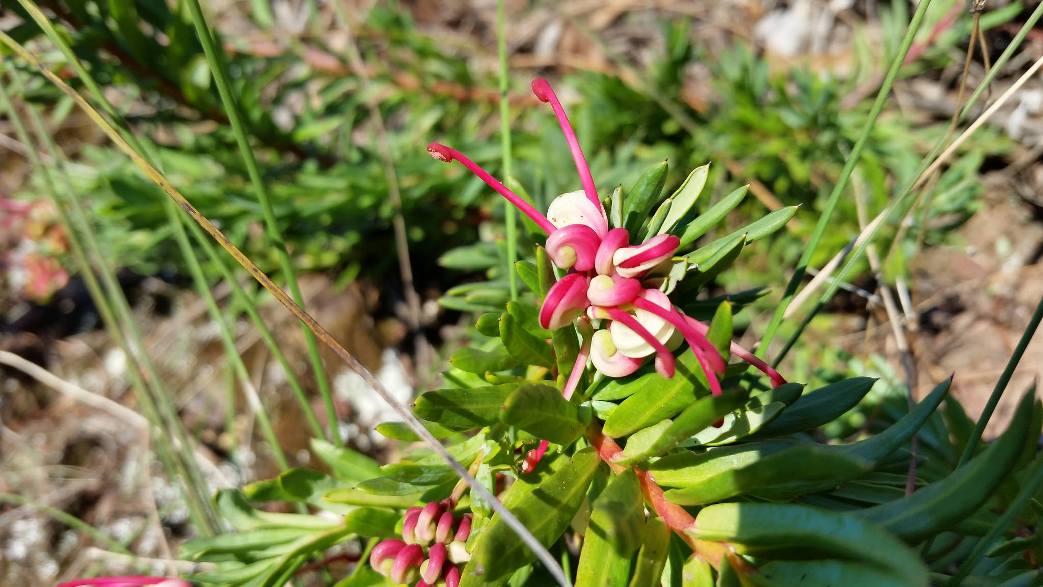 Wee Jasper grevillea (Grevillea iaspicula) in bloom- photo courtesy L.Lindsay- OEH
Wee Jasper grevillea (Grevillea iaspicula) in bloom- photo courtesy L.Lindsay- OEH
August 29, 2017: NPWS - OE&H
he critically endangered Wee Jasper Grevillea is flowering for the first time in 20 years in the Burrinjuck Nature Reserve after being protected by the NSW Government’s Saving our Species program.
Threatened Species Coordinator John Briggs said the thrill of seeing the plants at this site in full bloom is the exciting culmination of 30 years spent working to recover this species.
“The plant is only found in two places in the world, outside the town of Wee Jasper and on the slopes above Burrinjuck Dam,” said Mr Briggs.
“Unfortunately, this pretty cream-pink flowering shrub is a favourite food of feral goats and by the mid-1990s they had eaten all the plants at this site.
“As well as undertaking intensive feral goat control, we fenced the site to protect the few seedlings that emerged unscathed by the goats.
“We are now seeing firsthand how this work is paying off and last month observed the first flowers seen at this site in decades
“We paddled out to this remote site on the shores of Lake Burrinjuck and were greeted with small clusters of spider-like pink flowers nestled in among flourishing pointed green leaves.
“The plants will continue to flower in the coming months and over summer should start producing seed, hopefully resulting in even more recruitment at the site.
“Thanks to this fencing we counted around 150 seedlings that have established in recent years and we can’t wait to see these young adult plants mature and thus improve its chance of long term survival at the site,” Mr Briggs said.

Wee Jasper Grevillea seed bags - photo courtesy OE&H
The Saving Our Species team and the NSW National Parks and Wildlife Service will continue to monitor these sites every three months, maintain the fencing and continue strategic pest management.
For more information on the NSW Government’s Saving our Species program, visit: Saving our Species Program.

Wee Jasper grevillea (Grevillea iaspicula) in bloom- photo courtesy L.Lindsay- OEH
Concerns Regarding Radioactivity In Migratory Seafood Negated: Post Fukushima
August 30, 2017: Virginia Institute of Marine Science
When the Fukushima power plant released large quantities of radioactive materials into nearby coastal waters following Japan's massive 2011 earthquake and tsunami, it raised concerns as to whether eating contaminated seafood might impair human health -- not just locally but across the Pacific.
A new study by an international research team shows that those concerns can now be laid to rest, at least for consumption of meat from migratory marine predators such as tuna, swordfish, and sharks.
The team focused on cesium, a silvery metal with a large number of radioactive isotopes. Two of these, 134Cs and 137Cs, form when uranium fuel breaks down in nuclear reactors. The cesium isotopes are of particular concern because they were discharged in large quantities following the disaster, exhibit relatively long half-lives (2.1 and 30 years respectively), and tend to accumulate in the muscle tissues that people like to eat.
However, the team's sampling of tissues from predatory fishes and other large vertebrates collected across the northern Pacific between 2012 and 2015 revealed no detectable levels of 134Cs, and 137Cs concentrations that were generally consistent with background levels from aboveground nuclear testing during the 1940s and 50s. They collected the animals from waters near Japan, Hawaii, and California.
Lead author Daniel Madigan of Harvard University says, "Our measurements and associated calculations of how much radioactive cesium a person would ingest by eating this seafood shows that impacts to human health are likely to be negligible. For marketed fish to be restricted from trade, the cesium levels would have to be more than 1,600 times higher than in any samples we measured."
Co-author Kevin Weng, an assistant professor at William & Mary's Virginia Institute of Marine Science, participated in the study by collecting fish samples in waters around Oahu and a remote seamount. He says, "Go ahead and eat some sushi! Our work shows that radioactivity from the Fukushima disaster is very low in open-ocean vertebrates."
Also contributing to the study were Zofia Baumann and Nicholas Fisher of Stony Brook University; Owyn Snodgrass, Heidi Dewar, and Peter Dutton of NOAA's Southwest Fisheries Science Center; Michelle Berman-Kowalewski of the Channel Islands Cetacean Research Unit; and Jun Nishikawa of Tokai University.
The researchers undertook their analysis partly in response to earlier studies by Madigan and colleagues showing elevated levels of radioactive cesium in bluefin and albacore tuna caught off the California coast shortly after the Fukushima disaster -- evidence that these fishes had swum almost 6,000 miles in less than two months. (It took ocean currents more than two years to deliver much-diluted cesium from Fukushima to those same waters.)
Although this early work focused on the utility of cesium isotopes as a happenchance tool that could help scientists characterize migratory patterns among a group of heavily exploited commercial fishes, public attention focused on perceived risks to human health.
"The earlier studies showed extremely low risks from cesium to anyone eating these migratory species, but public concern persisted," says Weng. That concern also expanded to include not only the species of tuna in which cesium had been measured, but to other fishes, marine mammals, and sharks.
"People were very concerned about North Pacific salmon, halibut and scallops off British Columbia, and sea lions in Southern California," says Madigan. "There was even information on the Internet that 'the Pacific is dead'."
"One goal of our study," he says, "was to put these perceived risks in context by surveying a broad range of vertebrate species across the entire North Pacific for the presence or absence of Fukushima-derived radiocesium. Our results, which show very low or undetectable levels in these animals, are important both for public perception of seafood safety and for scientific understanding of radionuclide transfer."
The authors suggest that scientists and funding agencies should look for at least one silver lining in any future nuclear or industrial accidents. "We can and should use future point sources of contamination, radioactive or otherwise, to shed new light on migratory dynamics of pelagic species that are poorly understood, heavily exploited, or of high conservation concern," says Madigan. "But we would need to act quickly, within that narrow opportunistic timespan."
Daniel J. Madigan, Zofia Baumann, Owyn E. Snodgrass, Heidi Dewar, Michelle Berman-Kowalewski, Kevin C. Weng, Jun Nishikawa, Peter H. Dutton, Nicholas S. Fisher. Assessing Fukushima-Derived Radiocesium in Migratory Pacific Predators. Environmental Science & Technology, 2017; 51 (16): 8962 DOI: 10.1021/acs.est.7b00680
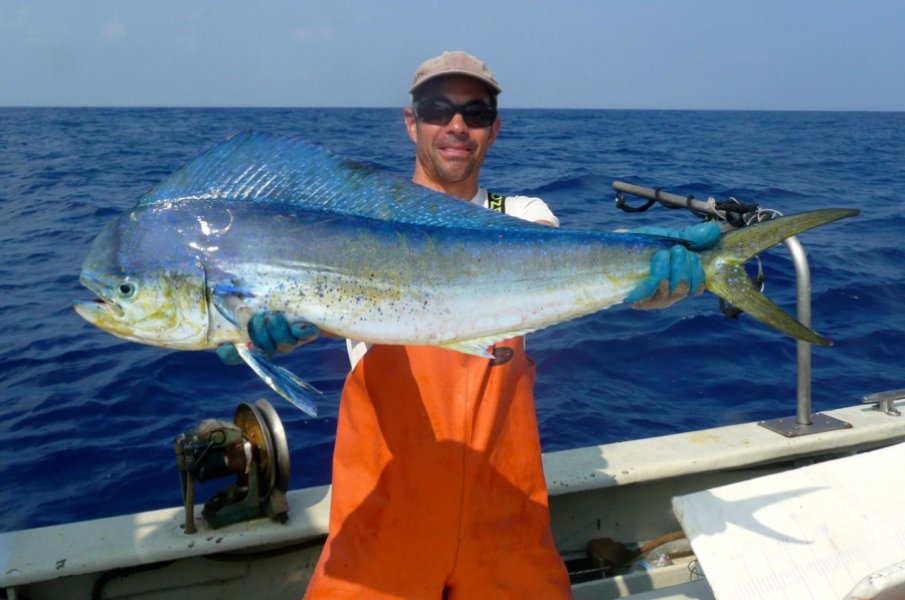
Assistant professor Kevin Weng of the Virginia Institute of Marine Science with a dolphinfish or mahi-mahi (Coryphaena hippurus) collected as part of the study of Fukushima-derived radioactivity in large Pacific Ocean predators. Credit: © A. Gray aboard FV Aoshibi IV.
August 30, 2017: Virginia Institute of Marine Science
When the Fukushima power plant released large quantities of radioactive materials into nearby coastal waters following Japan's massive 2011 earthquake and tsunami, it raised concerns as to whether eating contaminated seafood might impair human health -- not just locally but across the Pacific.
A new study by an international research team shows that those concerns can now be laid to rest, at least for consumption of meat from migratory marine predators such as tuna, swordfish, and sharks.
The team focused on cesium, a silvery metal with a large number of radioactive isotopes. Two of these, 134Cs and 137Cs, form when uranium fuel breaks down in nuclear reactors. The cesium isotopes are of particular concern because they were discharged in large quantities following the disaster, exhibit relatively long half-lives (2.1 and 30 years respectively), and tend to accumulate in the muscle tissues that people like to eat.
However, the team's sampling of tissues from predatory fishes and other large vertebrates collected across the northern Pacific between 2012 and 2015 revealed no detectable levels of 134Cs, and 137Cs concentrations that were generally consistent with background levels from aboveground nuclear testing during the 1940s and 50s. They collected the animals from waters near Japan, Hawaii, and California.
Lead author Daniel Madigan of Harvard University says, "Our measurements and associated calculations of how much radioactive cesium a person would ingest by eating this seafood shows that impacts to human health are likely to be negligible. For marketed fish to be restricted from trade, the cesium levels would have to be more than 1,600 times higher than in any samples we measured."
Co-author Kevin Weng, an assistant professor at William & Mary's Virginia Institute of Marine Science, participated in the study by collecting fish samples in waters around Oahu and a remote seamount. He says, "Go ahead and eat some sushi! Our work shows that radioactivity from the Fukushima disaster is very low in open-ocean vertebrates."
Also contributing to the study were Zofia Baumann and Nicholas Fisher of Stony Brook University; Owyn Snodgrass, Heidi Dewar, and Peter Dutton of NOAA's Southwest Fisheries Science Center; Michelle Berman-Kowalewski of the Channel Islands Cetacean Research Unit; and Jun Nishikawa of Tokai University.
The researchers undertook their analysis partly in response to earlier studies by Madigan and colleagues showing elevated levels of radioactive cesium in bluefin and albacore tuna caught off the California coast shortly after the Fukushima disaster -- evidence that these fishes had swum almost 6,000 miles in less than two months. (It took ocean currents more than two years to deliver much-diluted cesium from Fukushima to those same waters.)
Although this early work focused on the utility of cesium isotopes as a happenchance tool that could help scientists characterize migratory patterns among a group of heavily exploited commercial fishes, public attention focused on perceived risks to human health.
"The earlier studies showed extremely low risks from cesium to anyone eating these migratory species, but public concern persisted," says Weng. That concern also expanded to include not only the species of tuna in which cesium had been measured, but to other fishes, marine mammals, and sharks.
"People were very concerned about North Pacific salmon, halibut and scallops off British Columbia, and sea lions in Southern California," says Madigan. "There was even information on the Internet that 'the Pacific is dead'."
"One goal of our study," he says, "was to put these perceived risks in context by surveying a broad range of vertebrate species across the entire North Pacific for the presence or absence of Fukushima-derived radiocesium. Our results, which show very low or undetectable levels in these animals, are important both for public perception of seafood safety and for scientific understanding of radionuclide transfer."
The authors suggest that scientists and funding agencies should look for at least one silver lining in any future nuclear or industrial accidents. "We can and should use future point sources of contamination, radioactive or otherwise, to shed new light on migratory dynamics of pelagic species that are poorly understood, heavily exploited, or of high conservation concern," says Madigan. "But we would need to act quickly, within that narrow opportunistic timespan."
Daniel J. Madigan, Zofia Baumann, Owyn E. Snodgrass, Heidi Dewar, Michelle Berman-Kowalewski, Kevin C. Weng, Jun Nishikawa, Peter H. Dutton, Nicholas S. Fisher. Assessing Fukushima-Derived Radiocesium in Migratory Pacific Predators. Environmental Science & Technology, 2017; 51 (16): 8962 DOI: 10.1021/acs.est.7b00680

Assistant professor Kevin Weng of the Virginia Institute of Marine Science with a dolphinfish or mahi-mahi (Coryphaena hippurus) collected as part of the study of Fukushima-derived radioactivity in large Pacific Ocean predators. Credit: © A. Gray aboard FV Aoshibi IV.
Century-Old Seal Pelts Reveal Changes In Ross Sea Ecosystem
August 30, 2017When scientists at McMurdo Station in Antarctica have time off from their field work, they often pay a visit to three nearby wooden huts built in the early 1900s by Antarctic explorers Ernest Shackleton and Robert Falcon Scott. That's what UC Santa Cruz biologists Daniel Costa and Luis Huckstadt were doing on a day off from studying Weddell seals when they realized that a pile of frozen pelts in one of the huts represented samples of Weddell seal tissue from more than 100 years ago, at the very start of human activities in Antarctica.
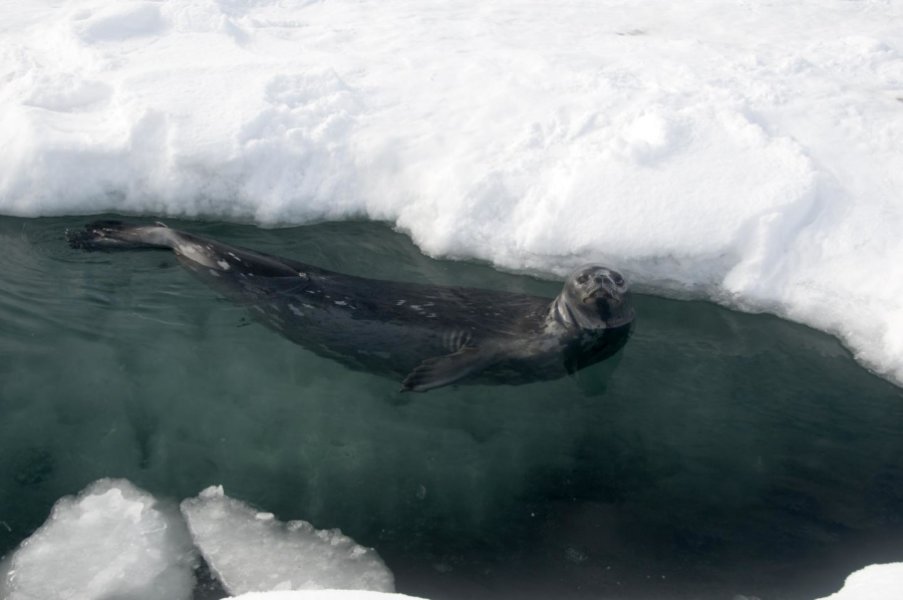
This is a Weddell seal swimming in McMurdo Sound, Ross Sea, Antarctica. Credit: Daniel P. Costa
By using sophisticated isotope analysis to compare samples from modern and century-old seals, the researchers were able to investigate an urgent question about human impacts on the Antarctic ecosystem: Is the targeting of Antarctic toothfish by a small fishing fleet operating in the Ross Sea changing the structure of the ecosystem and altering the diets of Weddell seals?
"People have hypothesized that the toothfish are being depleted and that, as a consequence, the Weddell seal has shifted its diet to Antarctic silverfish," said Huckstadt, a postdoctoral researcher in Costa's lab at UC Santa Cruz. "We'd been talking about this issue and realized we had the samples right there to test it."
Their findings, published August 30 in Proceedings of the Royal Society B, indicate that the seals' diets probably have not changed much over the past hundred years. But the results did reveal evidence of significant change in the phytoplankton community, the microscopic marine algae at the base of the entire food web in the Ross Sea. They attributed this change to a climatic shift that began with the end of a global cooling period known as the Little Ice Age, which lasted from about 1500 to 1900.
With permission from the Antarctic Heritage Trust, Huckstadt and Costa, a professor of ecology and evolutionary biology, collected samples of fur from 34 pelts for comparison with samples from modern-day seals. To analyze them, they teamed up with two colleagues at UC Santa Cruz who are experts in isotope analysis, professor of ocean sciences Matthew McCarthy and professor of Earth and planetary sciences Paul Koch, both coauthors of the paper.
"I first visited the historic huts in 1978 on my first trip to the Antarctic," Costa said. "I was amazed that the huts were left in the same condition as the day the explorers left 100 years ago. I saw seal pelts, penguin carcasses, and remains of sled dogs literally frozen in time. I always wondered if there was something we could do with this material. These relatively new isotope analyses provided us a way of using those frozen artifacts as a snapshot of the past."
Stable isotopes of carbon and nitrogen are widely used as tracers of ecological processes. As top predators in the Antarctic ecosystem, Weddell seals incorporate into their tissues isotopic tracers that have passed up through the entire food chain, carrying evidence of the structure of the ecosystem and of the position or "trophic level" of the seals within the system.
The researchers found that the historical "isotopic niche" of Weddell seals (as indicated by the variability of the carbon and nitrogen isotopes) was over five times larger than the modern niche. This could reflect a more highly specialized diet in modern Weddell seals, but this seems unlikely given the diversity of their prey today.
Furthermore, an analysis of nitrogen isotopes in specific amino acids showed that the trophic level of Weddell seals is unchanged, suggesting they are still eating the same kinds of fish as they did historically. Currently, Antarctic toothfish appears to make up less than 10 percent of the diet of Weddell seals, and the findings suggest this was also the case 100 years ago.
Changes in the sources of nitrogen and the composition of the phytoplankton community are more likely to account for the differences seen in the isotope data, Huckstadt said. "It looks more like a shift at the base of the food web, probably related to the transition from the Little Ice Age to current conditions, causing changes in the phytoplankton community," he said.
Although human activities are beginning to have impacts on the Ross Sea ecosystem, it remains relatively undamaged. This makes protecting the area and regulating human activities especially important, Huckstadt said. In 2016, after lengthy international negotiations, the Ross Sea was designated as the world's largest marine protected area by the Commission for the Conservation of Antarctic Marine Living Resources.
"It's not quite pristine, but it's about as pure an ecosystem as you're going to find on this planet," Huckstadt said. "Hopefully we can keep it that way."
This research was funded by the Marine Conservation Institute and the National Science Foundation.
Luis A. Hückstädt, Matthew D. McCarthy, Paul L. Koch, Daniel P. Costa. What difference does a century make? Shifts in the ecosystem structure of the Ross Sea, Antarctica, as evidenced from a sentinel species, the Weddell seal. Proceedings of the Royal Society B: Biological Sciences, 2017; 284 (1861): 20170927 DOI: 10.1098/rspb.2017.0927
August 30, 2017
When scientists at McMurdo Station in Antarctica have time off from their field work, they often pay a visit to three nearby wooden huts built in the early 1900s by Antarctic explorers Ernest Shackleton and Robert Falcon Scott. That's what UC Santa Cruz biologists Daniel Costa and Luis Huckstadt were doing on a day off from studying Weddell seals when they realized that a pile of frozen pelts in one of the huts represented samples of Weddell seal tissue from more than 100 years ago, at the very start of human activities in Antarctica.

This is a Weddell seal swimming in McMurdo Sound, Ross Sea, Antarctica. Credit: Daniel P. Costa
By using sophisticated isotope analysis to compare samples from modern and century-old seals, the researchers were able to investigate an urgent question about human impacts on the Antarctic ecosystem: Is the targeting of Antarctic toothfish by a small fishing fleet operating in the Ross Sea changing the structure of the ecosystem and altering the diets of Weddell seals?
"People have hypothesized that the toothfish are being depleted and that, as a consequence, the Weddell seal has shifted its diet to Antarctic silverfish," said Huckstadt, a postdoctoral researcher in Costa's lab at UC Santa Cruz. "We'd been talking about this issue and realized we had the samples right there to test it."
Their findings, published August 30 in Proceedings of the Royal Society B, indicate that the seals' diets probably have not changed much over the past hundred years. But the results did reveal evidence of significant change in the phytoplankton community, the microscopic marine algae at the base of the entire food web in the Ross Sea. They attributed this change to a climatic shift that began with the end of a global cooling period known as the Little Ice Age, which lasted from about 1500 to 1900.
With permission from the Antarctic Heritage Trust, Huckstadt and Costa, a professor of ecology and evolutionary biology, collected samples of fur from 34 pelts for comparison with samples from modern-day seals. To analyze them, they teamed up with two colleagues at UC Santa Cruz who are experts in isotope analysis, professor of ocean sciences Matthew McCarthy and professor of Earth and planetary sciences Paul Koch, both coauthors of the paper.
"I first visited the historic huts in 1978 on my first trip to the Antarctic," Costa said. "I was amazed that the huts were left in the same condition as the day the explorers left 100 years ago. I saw seal pelts, penguin carcasses, and remains of sled dogs literally frozen in time. I always wondered if there was something we could do with this material. These relatively new isotope analyses provided us a way of using those frozen artifacts as a snapshot of the past."
Stable isotopes of carbon and nitrogen are widely used as tracers of ecological processes. As top predators in the Antarctic ecosystem, Weddell seals incorporate into their tissues isotopic tracers that have passed up through the entire food chain, carrying evidence of the structure of the ecosystem and of the position or "trophic level" of the seals within the system.
The researchers found that the historical "isotopic niche" of Weddell seals (as indicated by the variability of the carbon and nitrogen isotopes) was over five times larger than the modern niche. This could reflect a more highly specialized diet in modern Weddell seals, but this seems unlikely given the diversity of their prey today.
Furthermore, an analysis of nitrogen isotopes in specific amino acids showed that the trophic level of Weddell seals is unchanged, suggesting they are still eating the same kinds of fish as they did historically. Currently, Antarctic toothfish appears to make up less than 10 percent of the diet of Weddell seals, and the findings suggest this was also the case 100 years ago.
Changes in the sources of nitrogen and the composition of the phytoplankton community are more likely to account for the differences seen in the isotope data, Huckstadt said. "It looks more like a shift at the base of the food web, probably related to the transition from the Little Ice Age to current conditions, causing changes in the phytoplankton community," he said.
Although human activities are beginning to have impacts on the Ross Sea ecosystem, it remains relatively undamaged. This makes protecting the area and regulating human activities especially important, Huckstadt said. In 2016, after lengthy international negotiations, the Ross Sea was designated as the world's largest marine protected area by the Commission for the Conservation of Antarctic Marine Living Resources.
"It's not quite pristine, but it's about as pure an ecosystem as you're going to find on this planet," Huckstadt said. "Hopefully we can keep it that way."
This research was funded by the Marine Conservation Institute and the National Science Foundation.
Luis A. Hückstädt, Matthew D. McCarthy, Paul L. Koch, Daniel P. Costa. What difference does a century make? Shifts in the ecosystem structure of the Ross Sea, Antarctica, as evidenced from a sentinel species, the Weddell seal. Proceedings of the Royal Society B: Biological Sciences, 2017; 284 (1861): 20170927 DOI: 10.1098/rspb.2017.0927
Tracking Down The Whale-Shark Highway
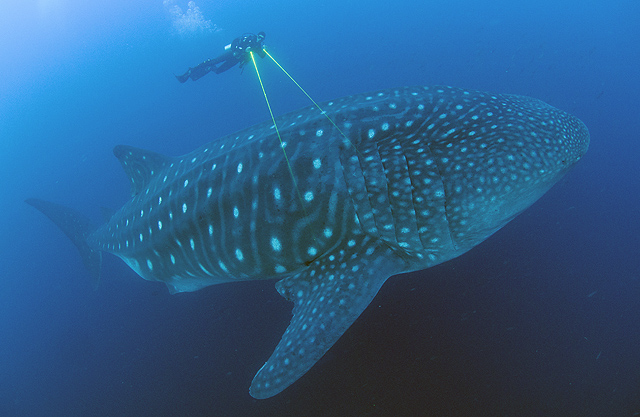
A whale shark near the Galapagos Islands being measured by a diver using laser photogrammetry. Photo © Jonathan Green/Galapagos Whale Shark Project
August 30, 2017: Monterey Bay Aquarium Research Institute
Did you know that August 30 is International Whale Shark Day? Whale sharks are the largest fishes on Earth, growing up to 18 meters (60 feet) long, but they feed mostly on tiny drifting animals such as copepods and, occasionally, small fish such as anchovies. To satisfy their immense appetites, whale sharks travel long distances to find dense swarms of prey.
MBARI biological oceanographer John Ryan recently worked with biologists who have been tracking whale sharks in the Eastern Tropical Pacific Ocean. They discovered that whale sharks in this area spend most of their time cruising along fronts—the dynamic boundaries between warm and cold ocean waters. This study, published today in the journal PLoS One, could help in the conservation of these endangered animals.
In 2011 and 2012, a team of researchers from Ecuador and England attached satellite tracking tags to 27 whale sharks at Darwin’s Arch, a geological feature about 200 kilometers (125 miles) northwest of the main Galapagos archipelago, and about two degrees north of the equator. This was the first time whale sharks had been tagged in the Eastern Tropical Pacific. The tagged sharks spent the next four to six months traveling east and west from this location across a 4,000-kilometer expanse of ocean, mostly staying between the equator and five degrees north latitude.
The researchers contacted Ryan to help them figure out how the whale-shark movements related to ocean conditions. This was a challenging task because ocean conditions are continually changing and whale sharks are always on the move.
Sea-surface temperatures, routinely measured by satellites, can reveal the oceanic features that whale sharks encounter during their large-scale movements. Ryan analyzed day-to-day changes in sea-surface temperature across the entire Eastern Tropical Pacific for the months when the whale sharks were being tracked. Because the Equatorial Pacific is often cloudy, Ryan used a combination of infrared and microwave radiation data from satellites (microwave radiation can pass through clouds).
When Ryan first looked at the whale-shark tracks in relation to the satellite data, he was struck by how consistent the tracks were. “The whale sharks could have ranged anywhere in the Eastern Tropical Pacific,” he said, “but they were primarily following frontal boundaries between warm and cold water.”
Extending across the Eastern Pacific is a distinct boundary between warm water north of the equator and colder water to the south. This boundary is called the North Pacific Equatorial Upwelling Front. Ryan’s analysis showed that whale sharks followed this front as if it was an open-ocean highway. When the front moved north and south in huge wave-like meanders, the whale sharks followed these meanders like semi trucks negotiating a winding mountain road.
Darwin's Arch, the whale-shark tagging site, is located right in the middle of the equatorial front. This could explain why whale sharks are often seen in the area, but rarely hang around for very long.
Ryan pointed out that the equatorial front is an environmental transition zone. "To the north of this zone, the water is warm and stable but there's not a lot of productivity," he explained. "To the south the water has high productivity, but is much colder."
He continued, "Previous studies showed that plankton [small, drifting plants and animals] can accumulate in this transitional zone. So this zone may be a good place for whale sharks to find dense food patches, while not getting too chilled by cold water."
Ryan also discovered that, when whale sharks approached the coasts of Central and South America, they followed fronts in these areas as well. Though less extensive than the equatorial front, these coastal fronts also form at boundaries between cold, high-productivity water and warm, less productive water. Whale sharks appear to head for these "secondary highways" in January or February, when the equatorial front typically weakens or disappears.
In an interesting side note, almost all of the whale sharks tracked in this experiment appeared to be pregnant females. The one adult male that was tracked followed a similar path as the females. Two juvenile whale sharks that were tracked followed different paths, farther away from the equatorial front.
In 2016, whale sharks were declared an endangered species, their numbers threatened by shark finning, entanglement in fishing gear, and boat collisions. But one of the biggest challenges in whale-shark conservation is simply coming up with good population estimates. By demonstrating that whale sharks can be found along fronts, this study will make it easier for marine biologists to estimate how many of these gentle giants are out there riding the rolling waves of the whale-shark highways.
John P. Ryan, Jonathan R. Green, Eduardo Espinoza, Alex R. Hearn. Association of whale sharks (Rhincodon typus) with thermo-biological frontal systems of the eastern tropical Pacific. PLOS ONE, 2017; 12 (8): e0182599 DOI: 10.1371/journal.pone.0182599

A whale shark near the Galapagos Islands being measured by a diver using laser photogrammetry. Photo © Jonathan Green/Galapagos Whale Shark Project
August 30, 2017: Monterey Bay Aquarium Research Institute
Did you know that August 30 is International Whale Shark Day? Whale sharks are the largest fishes on Earth, growing up to 18 meters (60 feet) long, but they feed mostly on tiny drifting animals such as copepods and, occasionally, small fish such as anchovies. To satisfy their immense appetites, whale sharks travel long distances to find dense swarms of prey.
MBARI biological oceanographer John Ryan recently worked with biologists who have been tracking whale sharks in the Eastern Tropical Pacific Ocean. They discovered that whale sharks in this area spend most of their time cruising along fronts—the dynamic boundaries between warm and cold ocean waters. This study, published today in the journal PLoS One, could help in the conservation of these endangered animals.
In 2011 and 2012, a team of researchers from Ecuador and England attached satellite tracking tags to 27 whale sharks at Darwin’s Arch, a geological feature about 200 kilometers (125 miles) northwest of the main Galapagos archipelago, and about two degrees north of the equator. This was the first time whale sharks had been tagged in the Eastern Tropical Pacific. The tagged sharks spent the next four to six months traveling east and west from this location across a 4,000-kilometer expanse of ocean, mostly staying between the equator and five degrees north latitude.
The researchers contacted Ryan to help them figure out how the whale-shark movements related to ocean conditions. This was a challenging task because ocean conditions are continually changing and whale sharks are always on the move.
Sea-surface temperatures, routinely measured by satellites, can reveal the oceanic features that whale sharks encounter during their large-scale movements. Ryan analyzed day-to-day changes in sea-surface temperature across the entire Eastern Tropical Pacific for the months when the whale sharks were being tracked. Because the Equatorial Pacific is often cloudy, Ryan used a combination of infrared and microwave radiation data from satellites (microwave radiation can pass through clouds).
When Ryan first looked at the whale-shark tracks in relation to the satellite data, he was struck by how consistent the tracks were. “The whale sharks could have ranged anywhere in the Eastern Tropical Pacific,” he said, “but they were primarily following frontal boundaries between warm and cold water.”
Extending across the Eastern Pacific is a distinct boundary between warm water north of the equator and colder water to the south. This boundary is called the North Pacific Equatorial Upwelling Front. Ryan’s analysis showed that whale sharks followed this front as if it was an open-ocean highway. When the front moved north and south in huge wave-like meanders, the whale sharks followed these meanders like semi trucks negotiating a winding mountain road.
Darwin's Arch, the whale-shark tagging site, is located right in the middle of the equatorial front. This could explain why whale sharks are often seen in the area, but rarely hang around for very long.
Ryan pointed out that the equatorial front is an environmental transition zone. "To the north of this zone, the water is warm and stable but there's not a lot of productivity," he explained. "To the south the water has high productivity, but is much colder."
He continued, "Previous studies showed that plankton [small, drifting plants and animals] can accumulate in this transitional zone. So this zone may be a good place for whale sharks to find dense food patches, while not getting too chilled by cold water."
Ryan also discovered that, when whale sharks approached the coasts of Central and South America, they followed fronts in these areas as well. Though less extensive than the equatorial front, these coastal fronts also form at boundaries between cold, high-productivity water and warm, less productive water. Whale sharks appear to head for these "secondary highways" in January or February, when the equatorial front typically weakens or disappears.
In an interesting side note, almost all of the whale sharks tracked in this experiment appeared to be pregnant females. The one adult male that was tracked followed a similar path as the females. Two juvenile whale sharks that were tracked followed different paths, farther away from the equatorial front.
In 2016, whale sharks were declared an endangered species, their numbers threatened by shark finning, entanglement in fishing gear, and boat collisions. But one of the biggest challenges in whale-shark conservation is simply coming up with good population estimates. By demonstrating that whale sharks can be found along fronts, this study will make it easier for marine biologists to estimate how many of these gentle giants are out there riding the rolling waves of the whale-shark highways.
John P. Ryan, Jonathan R. Green, Eduardo Espinoza, Alex R. Hearn. Association of whale sharks (Rhincodon typus) with thermo-biological frontal systems of the eastern tropical Pacific. PLOS ONE, 2017; 12 (8): e0182599 DOI: 10.1371/journal.pone.0182599
Call For Community Comment On Mawson’s Huts Management Plan
The community is invited to comment on the management plan for the site considered the birthplace of Australia’s Antarctic endeavours, Mawson’s Huts. The Huts were home to the Australasian Antarctic Expedition led by Sir Douglas Mawson between 1911–14.
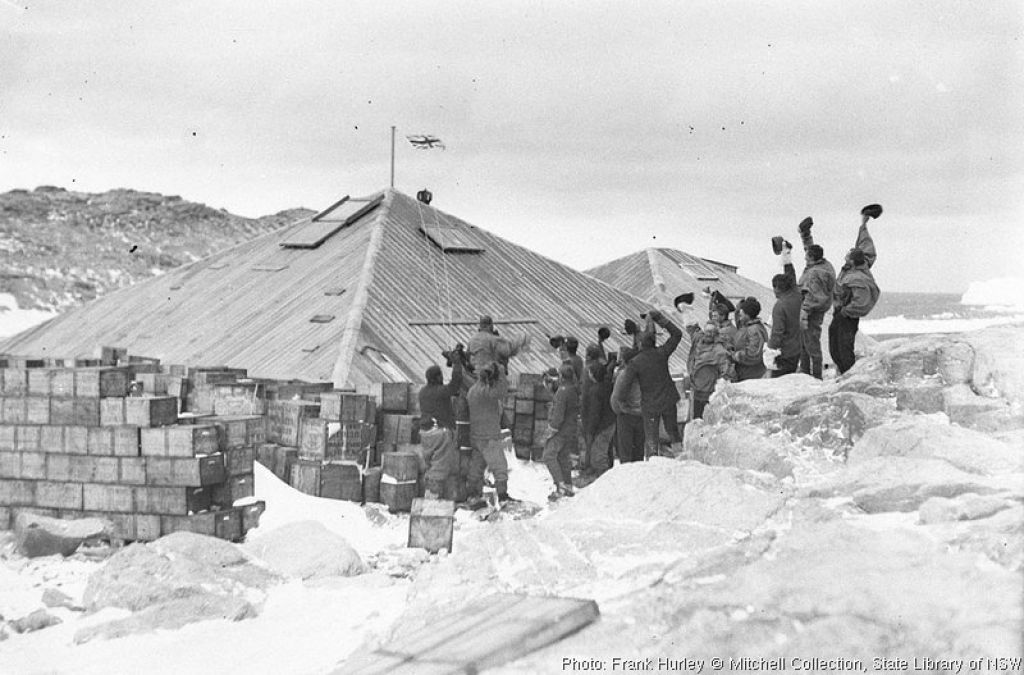
Raising the flag at Cape Denison after the erection of the hut, March 1912. (Photo: Frank Hurley)
The site is listed as a National Heritage place and Commonwealth Heritage place, with the Huts and surrounding area also protected under the Antarctic Treaty system.
The Australian Antarctic Division, which has responsibility for the management of the historic site, prepared the current version of the Mawson’s Huts Historic Site management plan in 2013. This plan is now up for its five year review and the public are invited to comment until 16 September.
Invitation to commentMawson’s Huts are a collection of buildings located at Cape Denison, Commonwealth Bay, in the far eastern sector of the Australian Antarctic Territory.
Mawson's Huts, Cape DenisonMawson’s Huts are a collection of buildings located at Cape Denison, Commonwealth Bay, in the far eastern sector of the Australian Antarctic Territory. The buildings were built and occupied by the Australasian Antarctic Expedition (AAE) of 1911–14, led by geologist and explorer Dr (later Sir) Douglas Mawson.
Mawson’s Huts are of national and international heritage significance. They are rare in a world context as one of just six complexes surviving from the ‘Heroic Era’ of Antarctic exploration: a period of great human adventure, exploration, research and discovery on the last continent to be explored.
The buildings are unique in the context of Australian history as the only surviving site representing the work of an Australian Antarctic expedition during this period. The site also has great heritage values for Australia’s Antarctic interests, since Douglas Mawson’s AAE was the foundation of the modern Australian Antarctic science program.
Mawson’s huts have suffered over the years from the effects of wind, ice and time. A number of recent expeditions by the AAD and the Mawson’s Huts Foundation (a non-profit organisation whose expeditions have been largely funded by the Australian Government) have sought to stabilise the remains.
Explore the Home of the Blizzard website to find out more about Mawson’s Huts and the Australasian Antarctic Expedition.
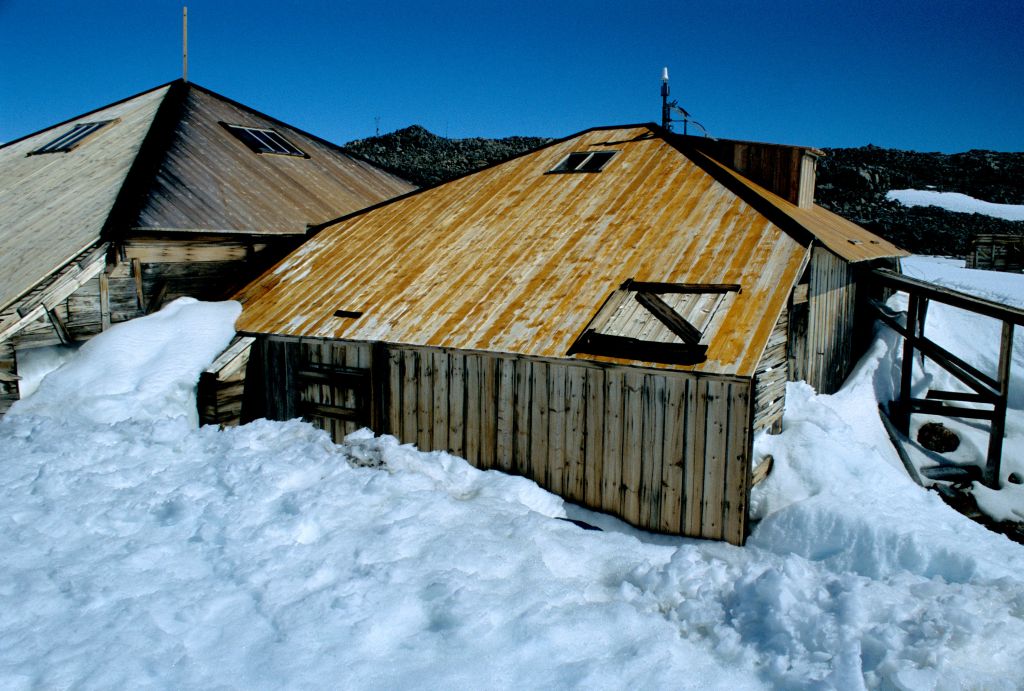
Mawson's main hut at Cape Denison, Commonwealth Bay (Photo: Peter McCabe)
Mawson's Huts Historic Site Management Plan In 2001, the Mawson’s Huts Foundation commissioned a conservation management plan for the site, which guided works at the site for several years. In 2007, the AAD developed a management plan, to meet its obligations arising from the inclusion of the site on the National Heritage List (in 2005) and Commonwealth Heritage List (in 2004), and to reflect the provisions of the Antarctic Treaty management plans for the Cape Denison Antarctic Specially Protected Area (ASPA) and Antarctic Specially Managed Area (ASMA).
This plan was reviewed and revised in 2013 and a management plan is available: Mawson’s Huts Historic Site Management Plan 2013–18 [PDF].
In 2014, ASMA No. 3 was de-designated and the boundary of ASPA No. 162 expanded to coincide with the previous ASMA boundary.
The Department of the Environment and Energy, Australian Antarctic Division, is conducting a review of the Mawson’s Huts Historic Site Management Plan. Public comments are now being sought. Please send your comments on the management plan by Saturday 16 September 2017.
COMMONWEALTH OF AUSTRALIA
Environment Protection and Biodiversity Conservation Act 1999Notice under sections 324W and 341XInvitation to comment on a Management Plan for a National Heritage place and Commonwealth Heritage place - Mawson’s Huts Historic Site
The Department of the Environment and Energy, Australian Antarctic Division, is conducting a review of The Mawson’s Huts Historic Site Management Plan. Public comments are now sought:
(i) as to whether this management plan is consistent with the National Heritage management principles;
(ii) on the effectiveness of the management plan in protecting and conserving the National Heritage management values of the site;
(iii) whether this management plan is consistent with the Commonwealth Heritage Management Principles; and
(iv) on the effectiveness of the plan in protecting and conserving the Commonwealth Heritage.
Download the Mawson’s Huts Management Plan 2013-2018 [PDF: 4.01MB].
Please send your comments on the management plan by Saturday 16 September 2017, by emailing Territories@antarctica.gov.au or writing to:
Mawson’s Huts Historic Site Management Plan reviewTerritories, Environment and Treaties SectionAustralian Antarctic Division203 Channel HighwayKingston TAS 7050
The community is invited to comment on the management plan for the site considered the birthplace of Australia’s Antarctic endeavours, Mawson’s Huts. The Huts were home to the Australasian Antarctic Expedition led by Sir Douglas Mawson between 1911–14.

Raising the flag at Cape Denison after the erection of the hut, March 1912. (Photo: Frank Hurley)
The site is listed as a National Heritage place and Commonwealth Heritage place, with the Huts and surrounding area also protected under the Antarctic Treaty system.
The Australian Antarctic Division, which has responsibility for the management of the historic site, prepared the current version of the Mawson’s Huts Historic Site management plan in 2013. This plan is now up for its five year review and the public are invited to comment until 16 September.
Invitation to comment
Mawson’s Huts are a collection of buildings located at Cape Denison, Commonwealth Bay, in the far eastern sector of the Australian Antarctic Territory.
Mawson's Huts, Cape Denison
Mawson’s Huts are a collection of buildings located at Cape Denison, Commonwealth Bay, in the far eastern sector of the Australian Antarctic Territory. The buildings were built and occupied by the Australasian Antarctic Expedition (AAE) of 1911–14, led by geologist and explorer Dr (later Sir) Douglas Mawson.
Mawson’s Huts are of national and international heritage significance. They are rare in a world context as one of just six complexes surviving from the ‘Heroic Era’ of Antarctic exploration: a period of great human adventure, exploration, research and discovery on the last continent to be explored.
The buildings are unique in the context of Australian history as the only surviving site representing the work of an Australian Antarctic expedition during this period. The site also has great heritage values for Australia’s Antarctic interests, since Douglas Mawson’s AAE was the foundation of the modern Australian Antarctic science program.
Mawson’s huts have suffered over the years from the effects of wind, ice and time. A number of recent expeditions by the AAD and the Mawson’s Huts Foundation (a non-profit organisation whose expeditions have been largely funded by the Australian Government) have sought to stabilise the remains.
Explore the Home of the Blizzard website to find out more about Mawson’s Huts and the Australasian Antarctic Expedition.

Mawson's main hut at Cape Denison, Commonwealth Bay (Photo: Peter McCabe)
Mawson's Huts Historic Site Management Plan
In 2001, the Mawson’s Huts Foundation commissioned a conservation management plan for the site, which guided works at the site for several years. In 2007, the AAD developed a management plan, to meet its obligations arising from the inclusion of the site on the National Heritage List (in 2005) and Commonwealth Heritage List (in 2004), and to reflect the provisions of the Antarctic Treaty management plans for the Cape Denison Antarctic Specially Protected Area (ASPA) and Antarctic Specially Managed Area (ASMA).
This plan was reviewed and revised in 2013 and a management plan is available: Mawson’s Huts Historic Site Management Plan 2013–18 [PDF].
In 2014, ASMA No. 3 was de-designated and the boundary of ASPA No. 162 expanded to coincide with the previous ASMA boundary.
The Department of the Environment and Energy, Australian Antarctic Division, is conducting a review of the Mawson’s Huts Historic Site Management Plan. Public comments are now being sought. Please send your comments on the management plan by Saturday 16 September 2017.
COMMONWEALTH OF AUSTRALIA
Environment Protection and Biodiversity Conservation Act 1999
Notice under sections 324W and 341X
Invitation to comment on a Management Plan for a National Heritage place and Commonwealth Heritage place - Mawson’s Huts Historic Site
The Department of the Environment and Energy, Australian Antarctic Division, is conducting a review of The Mawson’s Huts Historic Site Management Plan. Public comments are now sought:
(i) as to whether this management plan is consistent with the National Heritage management principles;
(ii) on the effectiveness of the management plan in protecting and conserving the National Heritage management values of the site;
(iii) whether this management plan is consistent with the Commonwealth Heritage Management Principles; and
(iv) on the effectiveness of the plan in protecting and conserving the Commonwealth Heritage.
Download the Mawson’s Huts Management Plan 2013-2018 [PDF: 4.01MB].
Please send your comments on the management plan by Saturday 16 September 2017, by emailing Territories@antarctica.gov.au or writing to:
Mawson’s Huts Historic Site Management Plan review
Territories, Environment and Treaties Section
Australian Antarctic Division
203 Channel Highway
Kingston TAS 7050
Muogamarra Season 2017
Hidden wildflower garden open for just six weekends31 July 2017: NPWS and NSW OE&HA hidden wildflower garden with a rare collection of botanical treasures and native plant species will open its gates this August and September for six weekends only.
NSW National Parks and Wildlife Service (NPWS) Area Manager Michele Cooper said Muogamarra Nature Reserve-just north of Sydney-is home to more than 900 species of native plants as well as the remnants of an ancient volcano.
"Muogamarra is home to a vast range of Australian wildflowers such as native orchids, towering Gymea lily, pink Boronia, eriostemon and old-man Banksia, which makes it a spectacular wildflower destination," said Ms Cooper.
"This unique array of flora and fauna is one reason why we need to limit the opening times to just six weekends each year to allow it to flourish, to preserve the fragile ecosystems and to protect the reserve's Aboriginal cultural heritage.
"This year during our open season, visitors can join a Discovery guided tour on foot or on a kayak and discover the secrets of this special place," she said.
Some of the walking tracks in the reserve provide outstanding views of the Hawkesbury, Aboriginal rock engravings and convict built roads, and other tracks wind through rainforest and historic relics.
One of the guided walks leads people down to Peat's Crater, which is an unusual volcanic structure called a diatreme that is not found in many parts of Australia.
"By joining a guided walk you'll will see and learn all the secrets of the reserve that you might miss by going on your own," said Ms Cooper.
The launch weekend (12-13 August) will also mark the 50th anniversary of NPWS.
"The Muogamarra open season will launch on Saturday 12 August with a Welcome to Country by Uncle Ray Davison, cultural workshops throughout the day delivered by Aboriginal Discovery Ranger Jess Sinnott, and activities for young children including free show bags for the first 50 children," said Ms Cooper.
"While visitors can certainly come along on any of the weekends during our open season and explore the park at their own pace, keep in mind that the Discovery walks and kayak tours will need to be pre-booked online as numbers are limited and places can fill up quickly," she said.
Muogamarra Nature Reserve will open to the public every Saturday and Sunday from Saturday 12 August until Sunday 17 September 2017.
What's on- Discovery tours include the Muogamarra Highlights Walk (new in 2017), Muogamarra Bird Gully Walk, Muogamarra Lloyd Trig Walk and Muogamarra Peats Bight Walk.
- A kayaking tour is also available: Paddle our Parks Muogamarra, the first of which will take place on Saturday 12 August.
- An event in celebration of the NPWS 50 Year Anniversary will take place on the first weekend (12 - 13 August).
More informationPrior bookings are essential for the guided walks and kayak tours and can be made by visiting the NPWS website:
Muogamurra Nature Reserve is located on the western side of the Pacific Highway, 3.35 kilometres north of Cowan Station.
A park access fee applies during the 6 annual open weekends of $15 for adults, $10 for children, and $40 for families of 2 adults and 2 children.
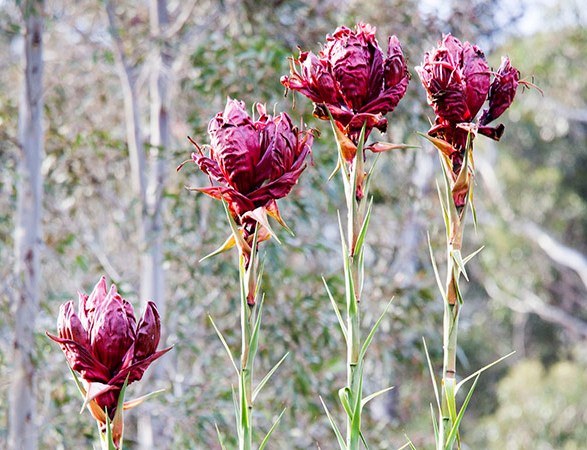
Hidden wildflower garden open for just six weekends
31 July 2017: NPWS and NSW OE&H
A hidden wildflower garden with a rare collection of botanical treasures and native plant species will open its gates this August and September for six weekends only.
NSW National Parks and Wildlife Service (NPWS) Area Manager Michele Cooper said Muogamarra Nature Reserve-just north of Sydney-is home to more than 900 species of native plants as well as the remnants of an ancient volcano.
"Muogamarra is home to a vast range of Australian wildflowers such as native orchids, towering Gymea lily, pink Boronia, eriostemon and old-man Banksia, which makes it a spectacular wildflower destination," said Ms Cooper.
"This unique array of flora and fauna is one reason why we need to limit the opening times to just six weekends each year to allow it to flourish, to preserve the fragile ecosystems and to protect the reserve's Aboriginal cultural heritage.
"This year during our open season, visitors can join a Discovery guided tour on foot or on a kayak and discover the secrets of this special place," she said.
Some of the walking tracks in the reserve provide outstanding views of the Hawkesbury, Aboriginal rock engravings and convict built roads, and other tracks wind through rainforest and historic relics.
One of the guided walks leads people down to Peat's Crater, which is an unusual volcanic structure called a diatreme that is not found in many parts of Australia.
"By joining a guided walk you'll will see and learn all the secrets of the reserve that you might miss by going on your own," said Ms Cooper.
The launch weekend (12-13 August) will also mark the 50th anniversary of NPWS.
"The Muogamarra open season will launch on Saturday 12 August with a Welcome to Country by Uncle Ray Davison, cultural workshops throughout the day delivered by Aboriginal Discovery Ranger Jess Sinnott, and activities for young children including free show bags for the first 50 children," said Ms Cooper.
"While visitors can certainly come along on any of the weekends during our open season and explore the park at their own pace, keep in mind that the Discovery walks and kayak tours will need to be pre-booked online as numbers are limited and places can fill up quickly," she said.
Muogamarra Nature Reserve will open to the public every Saturday and Sunday from Saturday 12 August until Sunday 17 September 2017.
What's on
- Discovery tours include the Muogamarra Highlights Walk (new in 2017), Muogamarra Bird Gully Walk, Muogamarra Lloyd Trig Walk and Muogamarra Peats Bight Walk.
- A kayaking tour is also available: Paddle our Parks Muogamarra, the first of which will take place on Saturday 12 August.
- An event in celebration of the NPWS 50 Year Anniversary will take place on the first weekend (12 - 13 August).
More information
Prior bookings are essential for the guided walks and kayak tours and can be made by visiting the NPWS website:
Muogamurra Nature Reserve is located on the western side of the Pacific Highway, 3.35 kilometres north of Cowan Station.
A park access fee applies during the 6 annual open weekends of $15 for adults, $10 for children, and $40 for families of 2 adults and 2 children.

Bushcare’s Major Day Out At Mona Vale 2017
Mona Vale Bushcare and Pittwater Natural Heritage Association have been awarded a Stronger Communities Grant to continue the restoration of the coastal dune and littoral rainforest at the end of Basset Street. The Bushcare group will continue to remove weeds, replant native species and encourage natural regeneration. The $12,000 received will be used to support the group through contract bush regeneration and the purchase of native plants.
This site has been chosen for Bushcare volunteers to come together and join in the nationwide “Bushcare’s Major Day Out” event to support all our local volunteers working to conserve and restore our unique natural environment.
When: September 17, 2017 - 8.30 a.m.to 12p.m.Where: Mona Vale Basin Beach Reserve, at the end of Bassett Street Mona Vale
Mona Vale Bushcare and Pittwater Natural Heritage Association have been awarded a Stronger Communities Grant to continue the restoration of the coastal dune and littoral rainforest at the end of Basset Street. The Bushcare group will continue to remove weeds, replant native species and encourage natural regeneration. The $12,000 received will be used to support the group through contract bush regeneration and the purchase of native plants.
This site has been chosen for Bushcare volunteers to come together and join in the nationwide “Bushcare’s Major Day Out” event to support all our local volunteers working to conserve and restore our unique natural environment.
When: September 17, 2017 - 8.30 a.m.to 12p.m.
Where: Mona Vale Basin Beach Reserve, at the end of Bassett Street Mona Vale
Energy Locals For 100% Carbon Neutral Plans
From Surf Life Saving NSW Interested in 100% carbon neutral plans, huge solar feed in tariffs and Australian owned and operated in your energy provider? Look no further than SLSNSW's newest partner Energy Locals to see how they will revolutionise your energy plan: energylocals.com.au/providers/slsnsw
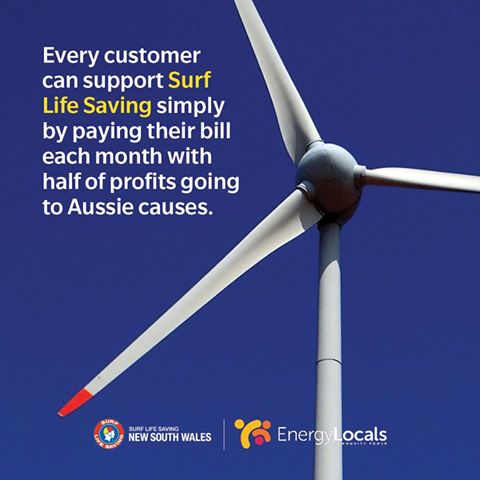
From Surf Life Saving NSW
Interested in 100% carbon neutral plans, huge solar feed in tariffs and Australian owned and operated in your energy provider? Look no further than SLSNSW's newest partner Energy Locals to see how they will revolutionise your energy plan: energylocals.com.au/providers/slsnsw

Bird Walks And Talks 2017: PNHA
Come and see and hear some of our fantastic native birds, many of which you'll never see in your garden. Join in a Sunday guided bird walk with Pittwater Natural Heritage Association. All walks start at 8am and end about 10am.
September 17 Irrawong reserve. Meet at corner Irrawong Rd and Epworth Rd.November 26 Warriewood Wetlands. Meet end of Katoa Close, north Narrabeen.
Bring binoculars if possible. Drink, hat and comfortable shoes.More information contact pnhabirdwatching@gmail.com or Ph Kerry on 0402 605 721.
You don't need to book but if we know you're coming we'll watch out for you. Call if in doubt about weather as we won't go out if it's raining.

Come and see and hear some of our fantastic native birds, many of which you'll never see in your garden. Join in a Sunday guided bird walk with Pittwater Natural Heritage Association. All walks start at 8am and end about 10am.
September 17 Irrawong reserve. Meet at corner Irrawong Rd and Epworth Rd.
November 26 Warriewood Wetlands. Meet end of Katoa Close, north Narrabeen.
Bring binoculars if possible. Drink, hat and comfortable shoes.
More information contact pnhabirdwatching@gmail.com or
Ph Kerry on 0402 605 721.
You don't need to book but if we know you're coming we'll watch out for you. Call if in doubt about weather as we won't go out if it's raining.

PhD Students Win Two Of Four NSW Medical Devices Fund Grants
August 30th, 2017: University of Sydney
Two revolutionary medical devices developed by University of Sydney PhD students were among the top innovations awarded nearly $3 million on Tuesday evening by the NSW Government’s NSW Medical Devices Fund.
A magic lantern-shaped microwave-emitting catheter to control high blood pressure and “Oli™”, a real-time monitoring pregnancy patch, were two of four medical devices awarded Medical Device Fund grants by NSW Health Minister Brad Hazzard at a ceremony at Parliament House last night.
They were two of four promising new medical devices awarded a share of $6.61 million in funding to bankroll their commercial development.
“The NSW Government is taking home-grown medical innovation to the next level, firmly placing this state at the forefront of global health technology,” Minister Hazzard said in a statement.
“This fund gives entrepreneurs the opportunity to get game-changing ideas to market, not only keeping medical device companies in NSW, but significantly improving health outcomes and even saving patients’ lives.”
Mu Catheter
A magic lantern-shaped microwave-emitting catheter that could control medication resistant hypertension was awarded $1.39 million by the NSW Medical Devices Fund.
The device known as a ‘Mu Catheter’ was co-invented by cardiologist Dr Pierre Qian and biomedical engineer Tony Barry, both PhD students with the University of Sydney and employed at Westmead Hospital in Sydney’s west.
This project is jointly owned and being commercialised by both University of Sydney and Western Sydney Local Health District. Dr Qian and Mr Barry will use the funds to further develop their catheter in a series of preclinical in vivo models, which if successful, may be used to treat medication resistant hypertension patients.
Treatment-resistant hypertension is the failure to achieve healthy blood pressure despite simultaneous use of at least three different antihypertensive medications. Patients with medication resistant hypertension have elevated risk of cardiovascular disease and death, and up to a threefold higher risk of heart attack, stroke, and death compared to patients whose hypertension that is well controlled.
“Hypertension is a major risk factor for cardiovascular disease, which is the leading cause of death worldwide,” said Dr Qian. “Twenty-eight percent of adults in NSW have hypertension, however up to one in eight patients fail to achieve blood pressure control despite multiple medications.”
The renal (kidney) artery is surrounded by highways of nerves that relay information between the kidneys and cardiovascular and nervous systems. These nerves are hyperactive in many people with difficult-to-control blood pressure, but they can be deactivated using heat.
Dr Qian and Mr Barry designed and built the magic lantern-shaped catheter that emits microwaves from within the renal artery to deactivate the hyperactive renal nerves. So far, lab testing and preliminary trials have shown promise.
“The results so far have been very encouraging and show that it is possible to deactivate the vast majority of the renal nerves without significant injury to the renal artery using this technology,” said Dr Qian.
"The Mu Catheter is based on angioplasty techniques well known to interventionists. It comprises a small microwave radiator deployed into the renal artery over a low-trauma angioplasty wire. The renal artery is - like most larger arteries in the body - prone to spasm in the presence of irritation of the inner wall, and the low-trauma approach over-the-wire avoids renal spasm during insertion. Once positioned in the artery, the wire is withdrawn.
"The radiator is surrounded by a sheath which can expand in the fashion of a magic lantern, to centre the radiator in the renal artery but still allow blood to flow through the artery while the procedure is underway. The sheath is also irrigated to assist in cooling the vessel during the ablation.
"The Mu Catheter radiates microwaves into the tissues surrounding the renal artery to provide a deep and circumferential ablation to consistently reach most of the renal nerves, while avoiding injury to the renal artery itself which is cooled and protected by blood flow. This is achieved through the Mu Catheter’s unique microwave emitting radiator, and centring mechanism.”
“Clinically available renal artery denervation devices heat and interrupt nerve supply to the renal nerves using an electrical current, but these have a limited depth of penetration and can’t be applied around the total circumference of the renal artery without injuring the artery wall,” explained Mr Barry. “These devices produce consistent spasm to the artery intra-operatively, inconsistent denervation and often have limited clinical efficacy.”
Dr Qian’s supervisor is Associate Professor Stuart Thomas, Clinical Senior Lecturer in Sydney Medical School and Director of the Cardiac Laboratories at Westmead Hospital, and Dr Aravinda Thiagalingam from Westmead Clinical School. Mr Barry’s supervisor is Professor Alistair McEwan from the Faculty of Engineering and Information Technologies.
Oli™
University of Sydney PhD student Sarah McDonald has been awarded $1.47 million by the NSW Medical Devices Fund to further develop a real-time monitoring pregnancy patch with potential to help cut rates of unnecessary interventions, and where needed, intervene earlier to avoid complications.
Known as ‘Oli™’ the patch Ms. McDonald says it “moves beyond traditional measures of contractions and fetal heart rate by allowing women to follow their own pregnancy and labor timelines, instead of a one-size-fits-all approach.”
Ms McDonald, a PhD candidate at the University of Sydney’s medical school is testing the proof-of-concept patch with pregnant women with the Royal Prince Alfred Hospital's Women and Babies team and has collected data from around 75 women to date.
Ms McDonald told Fairfax Media that traditonal device for measuring contractions and fetal heart rate “are the most uncomfortable things on the planet. For me as a mother, it added to the anxiety of the experience. I was frustrated because I knew we could do better with better technology in a less invasive way. Instead of just looking at contraction frequencies and fetal heart rate, we want to determine the quality of pregnancy and labour itself,” she said.
Ms McDonald was not able to disclose what measures her team were using while the device was under development.
The wireless patch would also allow women in labour to shower, have a bath and walk around, comforts current technology does not allow.
While Oli had the potential to benefit all women in labour, a second model is designed to monitor women with high-risk pregnancies in their final trimester.
Ms McDonald’s PhD supervisors are Professor Jon Hyett from the Central Clinical School and Royal Prince Alfred Hospital, Dr Graham Brooker from the Faculty of Engineering and Information Technologies and Dr Hala Phipps, Clinical Senior Lecturer in the Sydney Nursing School.
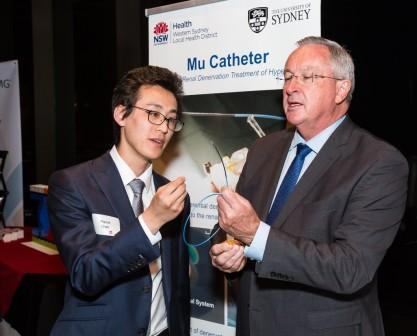
Dr Pierre Qian shows the Mu Catheter device to NSW Health Minister Brad Hazzard.
Australia Condemns North Korea Missile Test
29 August 2017
Prime Minister
Minister for Foreign Affairs
Australia strongly condemns North Korea’s latest ballistic missile test.
The missile flew over Japanese territory, posing an unacceptable threat to peace and stability in our region.
This morning’s test firing represents a serious escalation by Pyongyang. It is a provocative and threatening act by a dangerous regime.
North Korea’s nuclear weapons program is in violation of multiple United Nations Security Council resolutions and continues in defiance of repeated demands by the international community for the regime to halt these actions and focus the country’s resources on the welfare of its impoverished people.
Australia calls on all countries to fully implement existing UN Security Council resolutions to place pressure on Pyongyang to change its behaviour.
We also call on major economic partners of North Korea, including China and Russia, to use their bilateral economic leverage over Pyongyang to persuade the regime to abandon its illegal missile and nuclear weapons programs.
In addition to implementing all UN Security Council resolutions, Australia continues to implement a strong autonomous sanctions regime against individuals and entities supporting North Korea.
We will continue to work with our partners, including the United States, Japan, the Republic of Korea and China, to impose costs on the regime in order to end its threatening and destabilising behaviour.
Peter Conde Appointed AIS Director
29 August 2017: The Hon Greg Hunt MP, Minister for Sport
I welcome the appointment of Mr Peter Conde as the new Director of the Australian Institute of Sport (AIS).
Mr Conde assumes the position at an important time for Australian sport and the AIS will play a critical role in the development and implementation of our National Sports Plan.
The Plan will help shape the future of Australian sport across pillars of participation, high performance, preventive health and integrity.
Sport is of great value to the Australian community and the athletes who represent our country are an enormous source of pride. The AIS provides ongoing leadership, support and investment to help our athletes and sports achieve their best.
Mr Conde has great experience in sport and business strategy, the essential skills required to lead and influence Australia’s high performance sporting system.
Mr Conde was an elite sailor, twice achieving podium finishes in World Championships – Laser and Etchells.
Having built an impressive career as a business consulting strategist, including senior roles with AT Kearney, Mr Conde has dedicated himself to transformational change of Australian Sailing’s high performance program.
He was appointed to do a review of Australian Sailing’s high performance program after the 2004 Athens Olympics, where Australia did not medal. The sport has since become a beacon of Australian sporting success at Olympic and Paralympic Games.
Mr Conde has been High Performance Director of Australian Sailing since 2009. Australian Sailing has claimed a total four gold medal and four silver medals at the past two Olympic Games, including being the leading sailing nation at the 2012 London Olympics.
Next year will be a busy period for the AIS and high performance sport, with the Winter Olympic and Paralympic Games and the 2018 Gold Coast Commonwealth Games.
I would like to congratulate Mr Conde on his appointment and I look forward to working with him in his new role.
Museum Awards Grants To Preserve Australia's Rich Maritime Heritage
August 29, 2017: ANMM
The Australian National Maritime Museum, on behalf of the Australian Government, is pleased to announce that it has awarded over $125,000 to support projects to promote Australia’s maritime heritage. The successful recipients of the Maritime Museums of Australia Project Support Scheme will help, collect, conserve and display objects of historical significance.
The scheme provides grants of up to $15,000, internships and in-kind support from Australian National Maritime Museum experts, which includes support for staff and volunteers from regional and remote organisations, to learn how to develop educational and public programs that help promote Australia’s maritime collections.
Maritime museums and historical societies play an important role in preserving and sharing Australia’s maritime heritage and these grants will ensure important maritime objects are available now for future generations.
In 2017-18, funding was awarded to 11 organisations, in-kind support was offered to six organisations and internships were offered to seven applicants.
Museum director, Kevin Sumption, said, “As a national institution our mandate is to share Australia’s maritime history with people across the country and we are proud that the Maritime Museums of Australia Support Scheme is one of the key ways in which we fulfil this charter.”
Funding will support museums and historical societies to share their stories by assisting with conservation and interpretation projects including funding essential conservation works to the Ship’s anchor within the Dunbar Tomb in Camperdown Cemetery (NSW) as well as conservation work to the significant oil paintings in the Maritime Museum of Tasmania Collection (TAS).
Grants will also support research projects including the development of heritage interpretation along the Lake Macquarie Foreshore (NSW), a community engagement project promoting the maritime history of Palm Island (QLD), the development of a display on the history of Port Vincent (SA), and vessel management and interpretation advice for the Tathra Surf Boat (NSW) and HMAS Townsville (QLD)
Further funds and in-kind support will also support museums and historical societies across Australia to carry out conservation work and assessments, catalogue heritage objects and develop educational material.
The scheme which offers funding to non-profit museums, historical societies and organisations is supported by the Australian Government and is administered by the Australian National Maritime Museum. The next round of funding will be open for applications in February 2018.
For more information about the Maritime Museums of Australia Scheme and a full list of grant recipients visit www.anmm.gov.au/grants
The Australian National Maritime Museum in Sydney is the national centre for maritime collections, exhibitions, research and archaeology. As a Commonwealth cultural institution the museum is committed to fulfilling its national mandate by developing programs and opportunities to share its expertise, collection and the national maritime story with regional communities throughout Australia.
2017 Grant recipients
ACT
Submarine Institute of Australia Inc In-Kind Support
Australian National Submarine Museum (ANSM)
The Submarine Institute (SIA) intends to establish an online Australian National Submarine Museum (ANSM). The purpose of the Submarine Museum is to present to the public “The Story of Submarines in Australia”. In-kind support is awarded to investigate ways that the ANMM can assist with this project.
Internships – Norfolk Island Regional Council
Two internships were awarded to this organisation. Up to $2,500 each for a 1 week internship at the ANMM
NSW
Ballina Naval & Maritime Museum In-Kind Support
What’s her story? : the design and installation of the Florrie display
In-kind support for an ANMM exhibition designer to assist with planning the Florrie display. Florrie’s story will highlight historical aspects of timber vessel construction at Brisbane Water where she was constructed, as well as locally. It will also feature the story of Florrie’s place in the social history of the Port of Ballina and the Richmond River.
Internship - Ballina Naval & Maritime Museum
Up to $2,000 for a 1 week internship at the ANMM
Camperdown Cemetery Trust $15,000
Essential conservation works to the Ship’s anchor within the Dunbar Tomb and Precinct
The Dunbar tomb and precinct (1858), located in Camperdown Cemetery, is a mass grave memorial for the victims of the Dunbar shipwreck, a tragedy of great maritime significance. The proposed conservation works are planned in time for a 160th year memorial service.
Jervis Bay Maritime Museum In-Kind Support
Fleet Restoration: Restoration of ‘Crest/Ninon’ (ARHV No. HV000049) and ‘Kingfisher’ (ARHV No.HV000701)
Jervis Bay Maritime Museum will celebrate its 30th anniversary in December 2018. To mark this event the aim is to re-launch Crest and have Kingfisher at 80% completion to showcase vessels built in the Huskisson boat yards. In-kind support is awarded for an ANMM Curator to visit to conduct an inspection of the vessel Kingfisher and assist in the development of a conservation management plan.
Lake Macquarie City Council $13,000
Repackaging our Past: Lake Macquarie Maritime Heritage Project
For interpretive research and for the construction and placement of signage that details the significant maritime heritage of Lake Macquarie. Funding is to engage a suitably qualified Museum Historian / Curator to undertake research and develop interpretive text to be included on the Lake Macquarie foreshore promenade.
Richmond River Historical Society Inc. $5,750
Lismore by the Sea
The Society holds a number of artefacts relating to specific vessels that served on the North Coast run. This project is for the reorganization of the maritime display to contemporary professional standard with inclusion of interpretive media to elicit the role of the North Coast Steam Navigation Company in the maritime history of the region. Consultants will be engaged to facilitate the production of the display. Some unique and valuable artefacts relating to this story, including a lantern from the ‘Lady Franklin’, and a sextant, parallel rules and dividers owned by captain Hunter, master of the first ‘Wollongbar’ that was wrecked in Byron Bay in 1921 will be rehoused in display cabinets for highlighting and protection.
Tathra Pig & Whistle Line Museum $2,720
Preservation, interpretation and exhibition of the Tathra Surf Boat
The Tathra Surf Boat is a wooden framed, canvas covered double ended craft. The proposed project aims to ensure appropriate and ongoing public access to the vessel by undertaking preservation and interpretation of the craft which is rare and important part of the museum’s collection. The vessel has recently been listed on the Australian Register for Historic Vessels (ARHV) and the proposed project is based on recommendations contained in the vessel’s Conservation and Interpretation Plan.
QLD
Bwgcolman Community School $15,000
Palm Island Maritime Heritage Research Project
To engage students & members of the Palm Island Community in a maritime heritage project. Aims include; assisting students to develop research skills, record oral histories, engage with practical boat building & boat repairs skills development as well as to develop teaching and learning resources. The project will identify design details of boats traditionally built on Palm Island & investigate if one of these vessels could be recreated on the Island via a future project.
Discovery Coast Tourism and Commerce Inc. $15,000
The 1770 Experience
For the development of the Interpretation Concept Plan for the ‘1770 Experience’. The community’s plan is to celebrate Cook 250 in 1770 by creating a long lasting community asset including a monument, a botanic parkland and an interpretive centre, which tells the story of indigenous cultural heritage, environmental significance and Australian maritime history on the occasion of the 250th anniversary of Cook’s landing at the site of the Town of 1770.
Townsville Maritime Museum Limited $5,000
Professional support of the development of vessel management plan and vessel interpretation plan / program for HMAS Townsville (II)
The HMAS Townsville is currently located at the Port of Townsville, where she is undergoing preservation treatment. This project is planned to ensure ongoing vessel conservation management and also to prepare the vessel for public display.
Internship – North Stradbroke Island Historical Museum Inc.
Up to $1,500 for a 2 week internship at the Queensland Maritime Museum
SA
Alexandrina Council - Friends of PS Oscar W In-Kind Support
Bringing the Barge Dart back to the River - a project of restoration and community engagement
In-kind support is awarded for an ANMM Curator to visit Goolwa to conduct an inspection of the boat and assist in the preparation of a vessel management plan.
Port Vincent Progress Association Inc. $3,000
Historical Ports Display - Port Vincent
The aim of this project is to demonstrate the significance of shipping to the town of Port Vincent and its importance to the development of SA. This organisation plan to set up a weather proof display, in a prominent position, on the foreshore, adjacent to the original town wharf and jetty. Funding is awarded to engage an exhibition designer to develop a design document to plan the exhibition.
TAS
Maritime Museum of Tasmania $12,173
Conserving Tasmanian China Trade paintings
To have two significant oil paintings in the Maritime Museum’s collection repaired and conserved. The works, created by Chinese artists in Hong Kong are ships’ portraits of the Mary Blair and Wild Wave, two Tasmanian vessels engaged in the China trade around the 1860s. They can then be shared with the museum's community and visitors, along with the fascinating story Tasmania’s trade links with China during the 1800s.
Internship – Friends of Tasman Island Wildcare Inc.
Up to $2,500 for a 1 week internship at the ANMM
Review Into Mental Health Review Tribunal Begins
28 August 2017: Minister for Mental Health Tanya Davies and Attorney General Mark Speakman
Minister for Mental Health Tanya Davies and Attorney General Mark Speakman today announced the opening of public submissions for the Review into the operation of the Mental Health Review Tribunal (MHRT).
To support the Review, being led by the Hon Anthony Whealy QC, a detailed Discussion Paper outlining the current operation of the MHRT has been released.
“The Review will examine all aspects of the operations including how the Tribunal makes decision on applications for leave, the release of forensic mental health patients and ways to better support victims,” Mrs Davies said.
“All registered victims of forensic patients will be invited to contribute to the Review, to ensure their voices are heard.”
Written submissions will be open to the public for eight weeks during which time the Review team will conduct individual and group consultations, as well as an assessment of international best practice.
Mr Speakman said the Review will closely consider if current law and Tribunal procedures appropriately balance community safety, the interests of victims and their families, and the care and treatment needs of forensic patients.
“The opening of public submissions and release of the Discussion Paper provides community members and stakeholders the opportunity to meaningfully engage with the Review team,” Mr Speakman said.
Victims groups, mental health advocates, people with lived experience of mental illness, health, law enforcement and legal professionals are encouraged to make a written submission.
The Discussion Paper provides a current overview of the Tribunal in four key areas:
- Leave and release decisions
- Engagement of victims
- Prohibition on publication of namesand
- Appointment of tribunal members.
The final report, due at the end of the year, will outline recommendations for improved policy, legislation, administration and practice.
To make a written submission or for more information: Review of the Mental Health Review Tribunal in respect of forensic patients.
Facility To Keep Australians And Economy Healthy
31 August, 2017: CSIRO
Australia's breakthroughs in life-changing medicine including medical devices, vaccines and cell therapies are set to accelerate with a new facility that combines technology, research and medical science.
M2 has been created by CSIRO, Monash University and Monash Health Translation Precinct (MHTP).
The new 'one stop shop' will bring the best minds and technology together to turn great ideas into a reality for Australia's flourishing medtech industry and benefit millions of patients as a result of the breakthroughs expected.
Minister for Industry, Innovation and Science Senator Arthur Sinodinos, today officially launched the M2 precinct at CSIRO's new Biomedical Materials Translation Facility (BMTF) in Clayton, Victoria.
"From life-changing cochlear implants, to life-saving vaccines, world-first 3D printed bone and tissue replacements, Australia has an incredible track record when it comes to medical technologies and pharmaceuticals," Senator Sinodinos said.
"M2 will help to accelerate development of technology like this, not only vital for the improvement of the lives of Australians facing medial challenges, but also leading to job and economic growth for Australia."
Australia is home to more than 500 companies working in the Medical Technologies and Pharmaceuticals (MTP) sector. Many of these are small and medium enterprises, which can struggle to make the expensive, time consuming transition from prototype to clinically tested product.
M2 closes this gap for Australian businesses, providing a research ecosystem to transition new discoveries from the bench to prototyping, pre-clinical testing, industry evaluation and commercialisation.
"M2 leverages some of Australia's best medtech expertise, experience and equipment," CSIRO Director of Manufacturing Dr Keith McLean said.
"When a company comes to us we can use CSIRO and MHTP facilities to develop and analyse production scale prototypes, whilst the Monash Biomedical Imaging facility can provide advanced pre-clinical and clinical testing and imaging."
With global populations ageing and emerging markets seeking better health care, there's huge growth underway in the MTP sector. It's expected to be worth almost $3 trillion by 2025, while $18 billion and 28,000 new jobs could be added to the Australian economy over the next eight years.
"Monash is determined to help build a new, globally competitive biomedical industry with our partners," Monash University Provost and Senior Vice-President Professor Marc Parlange said.
"This initiative will deliver real health benefits to all Australians. Our healthcare spending is expected to almost double to 16 per cent of GDP by 2040. Cheaper and more effective medical solutions are better for our health and Australia's financial future."
This infrastructure is supported by the Science and Industry Endowment Fund.
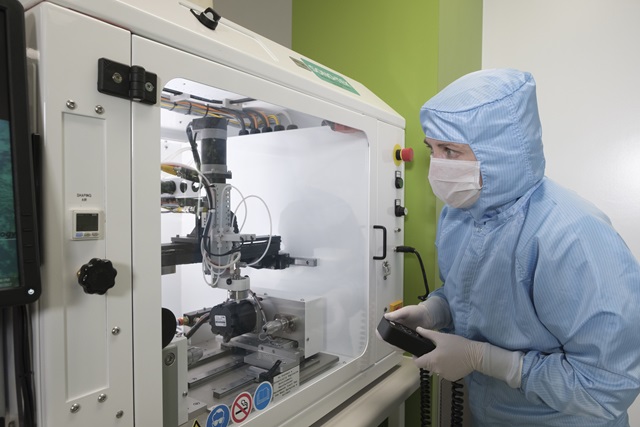
Australia is home to more than 500 companies working in the Medical Technologies and Pharmaceuticals (MTP) sector. ©CSIRO, Nick Pitsas
2017 Australian Museum Eureka Prize Winners
Thursday 31 August, 2017:
The nation’s most outstanding scientists have been honored at the 2017 Australian Museum Eureka Prizes Award Dinner, the “Oscars of Australian science”.
Australia’s premier science awards celebrated scientific breakthroughs from around the country, ranging from robots that are making Australia a world leader in farm automation, to technology that can reliably produce life-saving oxygen for newborns in hospitals.
Fifteen awards - worth $150,000 in prize money - were presented on Wednesday night (August 30), recognising excellence in science, research and innovation, scientific leadership and engagement, and school science across a broad spectrum – from environmental and innovative technologies, to national security, citizen science and for the first time, data science.
Eureka Prizes winners included scientists and researchers who have:
- discovered ways to help protect the Great Barrier Reef from the significant environmental damage caused by sediment runoff;
- developed a blood test that is twice as effective at detecting recurrent bowel cancer as existing methods;
- designed low-cost and reliable technology to help save the lives of newborn babies who die from a lack of oxygen and related lung infections, such as pneumonia;
- developed a nanoscale sterilizing material mimicking the surface of insect wings, to kill the bacteria that causes deadly golden staph infections;
- developed commercial robotic systems to boost Australia’s competitiveness in the fields of farming, aerospace, transportation and mining; and
- developed super-powered lasers to defend Australia against modern threats from drones and missiles.
Australian Museum Director and CEO Kim McKay AO said the Australian Museum Eureka Prizes represent the very best of Australian science.
“The Australian Museum Eureka Prize winners are helping to tackle some of the greatest challenges facing humanity and the planet,” she said.
“Australian scientists are world leaders in discovering ways to combat climate change, disease and threats to national security. Their scientific breakthroughs offer us insights into the innovations that will fundamentally change the way we live and work. The Australian Museum Eureka Prizes also recognized the importance of often-overlooked areas, such as scientific mentorship and school science,” she said. “Our award winners are fostering the nation’s next generation of scientific leaders and researchers.”
The winners of the 2017 Australian Museum Eureka Prizes were announced at a gala ceremony at the Sydney Town Hall on August 30, which was attended by Australia’s Chief Scientist Dr Alan Finkel AO, NSW Governor David Hurley, NSW Minister for Resources, Energy and Utilities, and the Arts Don Harwin MLC, NSW Minister for the Environment, Local Government, and Heritage Gabrielle Upton MP, NSW Chief Scientist Professor Mary O’Kane AC and leaders from the fields of science, government, industry, academia, research and innovation, and the media.
Winners of the 2017 Australian Museum Eureka Prizes
MELBOURNE, VIC
More than 1 million babies will die in their first month of life – up to half on the first day – and another 3.3 million children a year will not reach their fifth birthday. More than two thirds die because of lack of oxygen at birth (birth asphyxia), subsequent lung infections such as pneumonia or conditions associated with low blood oxygen levels or hypoxaemia. The University of Melbourne FREO2 team of global health experts, physicists and engineers, led by Dr Bryn Sobott, has won this year’s ANSTO Eureka Prize for Innovative Use of Technology for their technology that easily and cheaply produces medical grade oxygen without any electricity, which is crucial in countries where energy production is unreliable.
SYDNEY, NSW
Internationally recognized expert in the research, development and commercialization of robotic systems, the University of Sydney’s Professor Salah Sukkarieh, has won the CSIRO Eureka Prize for Leadership in Innovation and Science. His work has helped to make Australia a world leader in farm automation, in partnership with aerospace, transportation and mining industry end-users. Professor Sukkarieh leads the strategic research and industry engagement program in the world’s largest field robotics institute, the Australian Centre for Field Robotics. He also leads the research and translational program for the Rio Tinto Centre for Mine Automation and the Horticulture Innovation Centre for Robotics and Intelligent Systems.
MELBOURNE, VIC
By combining oxide materials with stretchable, rubber-like membranes, the winner of the Macquarie University Eureka Prize for Outstanding Early Career Researcher – RMIT University’s Associate Professor Madhu Bhaskaran – has developed malleable electronics that will revolutionise wearable devices, such as electronic skin patches that can warn when the wearer has been exposed to too much sun or patches that can diagnose sleep ailments.
PERTH, WA
Professor Andrew Whitehouse, from the Telethon Kids Institute and the University of Western Australia, in Perth, has been researching autism since he met a young boy with the condition when he was studying for his Speech-Language Therapy degree. The experience led to an extraordinary career as an autism researcher and advocate, for which he has been awarded the 3M Eureka Prize for Emerging Leader in Science.
BRISBANE, QLD
Associate Professor Andrew Brooks and the Catchment Sediment Budget Research Team from Griffith University, in Queensland, have been awarded the NSW Office of Environment and Heritage Eureka Prize for Environmental Research for their studies into what may be Australia's best chance of doing something timely to help save the Great Barrier Reef. They have identified new ways to dramatically reduce the damaging impact of sediment runoff, one of the most significant threats to the natural wonder - next to climate change.
SYDNEY, NSW AND ADELAIDE, SA
A national team of scientists has won the Johnson & Johnson Eureka Prize for Innovation in Medical Research for the development of a blood test that is twice as effective as existing non-invasive blood testing methods at detecting recurrent bowel cancer. Post-surgical recurrence of bowel cancer occurs in up to 40 per cent of cases, most often in the first three years following initial diagnosis and treatment. Dr Peter Molloy, Dr Jason Ross and Susan Mitchell, CSIRO, Sydney, NSW; Dr Susanne Pedersen and Dr Lawrence LaPointe, Clinical Genomics Pty Ltd Sydney, NSW, and Professor Graeme Young, Flinders University, Adelaide, SA developed the Colvera™ test, which became commercially available in the United States last year, to detect recurrent disease in patients previously treated for bowel cancer.
SYDNEY, NSW
The discovery that diamonds can massively extend the range, quality and power of lasers has led to Macquarie University’s Associate Professor Richard Mildren being named winner of the Defence Science and Technology Eureka Prize for Outstanding Science in Safeguarding Australia. If we are to be able to defend against modern threats from drones and missiles, we need something that is accurate and powerful enough to destroy an object that is a great distance away. While lasers are the obvious candidate, their development has been limited by insufficient power from the core laser material. Using man-made diamonds, Associate Professor Mildren has developed lasers with radically extended power and wavelength. The patented technology has attracted the attention of defence stakeholders worldwide, including funding from US defence agencies.
MELBOURNE, VIC
Professors Elena Ivanova and Saulius Juodkazis, from Victoria’s Swinburne University of Technology, have won the UNSW Eureka Prize for Scientific Research for a novel material able to kill the bacteria, Pseudomonas aeruginosa. The bacteria that causes conditions such as the deadly golden staph infections is becoming a global problem because of its ability to develop resistance to all existing antibiotics. Rather than developing a new chemical structure that can be commercialised into a drug, the team have instead developed a new nano-material by mimicking the surfaces of insect wings, such as the dragonfly and the cicada, which are naturally self sterilising.
SYDNEY, NSW AND ARNHEM LAND, NT
Macquarie University scientists and 300 Aboriginal elders and youth in the South-East Arnhem Land Indigenous Protected Area have collaborated to develop Ngukurr Wi Stadi bla Kantri (We study the Country), a unique project aimed at managing local natural and cultural assets. The team of Dr Emilie Ens, Macquarie University, Ngandi Elder Cherry Wulumirr Daniels, the Yugul Mangi Rangers, Ngukurr School and members from the remote Aboriginal community of Ngukurr, have been awarded the Department of Industry, Innovation and Science Eureka Prize for Innovation in Citizen Science.
MELBOURNE, VIC
Professor Geoffrey Webb, from the Monash University eResearch Centre in Melbourne, has won the inaugural University of Technology Sydney Eureka Prize for Excellence in Data Science for his research developing programs that take enormous amounts of raw data and extract information to improve the health of Australians, generally using just his laptop - when the majority of big data miners use supercomputers. His work has been critical to the development of advanced machine-learning techniques that can determine blood pressure from skin micro-patches. Able to be worn all the time, these patches provide real-time monitoring of heart rate and hypertension in patients who are at risk of heart attack.
ADELAIDE, SA
A collaborative project between the University of Adelaide, the South Australian Museum, and Aboriginal families and communities has been awarded the UNSW Eureka Prize for Excellence in Interdisciplinary Research. The Aboriginal Heritage Project, led byProfessor Alan Cooper from the University of Adelaide’s Australian Centre for Ancient DNA, is using DNA to construct the first map of Indigenous Australia prior to the arrival of Europeans and has revealed the continuous occupation of this country for about 50,000 years.
MELBOURNE, VIC, SYDNEY, NSW, FIJI AND SOLOMON ISLANDS
Scabies affects more than 200 million people, particularly children, having its greatest impact on people in low and middle-income families, yet the methods of treatment have remained unchanged for decades. A research group from the Murdoch Children’s Research Institute (MCRI) in Melbourne, the University of New South Wales (UNSW), and the Ministries of Health of Fiji and the Solomon Islands, led by the MCRI’s Associate Professor Andrew Steer, has won the Australian Infectious Diseases Research Centre Eureka Prize for Infectious Diseases Research for their studies into the prevalence of the disease and their world-first studies that almost eradicated scabies from communities in Fiji and the Solomon Islands.
SYDNEY, NSW
In recognition of the importance that mentoring plays in developing Australia’s young researchers into the next generation of lab leaders, industry heads and directors of research institutions, the University of New South Wales’ Professor Justin Gooding has been named as the winner of the University of Technology Sydney Eureka Prize for Outstanding Mentor of Young Researchers.
MELBOURNE, VIC AND SYDNEY, NSW
Becoming Superhuman is a two-part documentary produced by The Feds Australia that aired on ABC TV’s Catalyst program and has won theDepartment of Industry, Innovation and Science Eureka Prize for Science Journalism. Becoming Superhuman details how biomedical engineer Dr Jordan Nguyen works with 13-year-old Riley Saban, who has cerebral palsy, to develop a technology to help Riley do things he had previously been unable to do, such as switch on a light, operate a TV and even drive a car. It’s the second win in a row for writer/director Mr Wain Fimeri, who collaborated with The Feds Australia Julia Peters, Ili Baré and Lizzy Nash on this documentary.
SYDNEY, NSW
Year 4 students from the Presbyterian Ladies’ College in Sydney, Caitlyn Walker and Amelia Lai, are the winners of the University of Sydney Sleek Geeks Science Eureka Prize for Primary students. The nine-year-olds made their winning film, Icy Cold But Toasty Warm, to explain how the penguins of Antarctica stay warm. Their entertaining short film details experiments and models to show how the birds use feathers, blubber, counter-current heat exchange, size and huddling to survive extremely cold conditions.
CAIRNS, QLD
For the second year in a row, students from St Monica’s College in Cairns have won the University of Sydney Sleek Geeks Science Eureka Prize for Secondary students. Year 11 students, Claire Galvin and Anna Hardy, (who won the same category last year) were joined by Eliza Dalziel and Georgia Hannah, from Year 12, to create a film that explains the importance of dung beetles in our ecosystem. With their film, Manure You Know, they explain – using animation, video and experiments – how one of the world’s hardest-working insects has helped farmers on the Atherton Tablelands in Queensland improve their farming practices.
Learn more about the 2017 Australian Museum Eureka Prizes finalists and winners: australianmuseum.net.au/eureka
SNOWY HYDRO 2.0 POWERING AHEAD
28 August 2017
Prime Minister
Snowy Hydro 2.0 is already employing 350 people and will create more than 5000 new jobs during the construction phase of the development.
The game changing project, will have enough capacity to provide 350,000 MW/h of power for a week, enough to meet peak demand continuously for 500,000 homes.
Snowy Hydro 2.0 will help safeguard the energy security of the eastern seaboard, particularly on hot summer days and cold winter nights, while providing a jobs bonanza during the construction phase.
The Turnbull Government today confirmed a new $8 million accelerated agreement between the Australian Renewable Energy Agency and Snowy Hydro had been reached to drive planning for the construction of the project and insight for future pumped hydro projects into the future.
ARENA is finalising details on the injection of funding with Snowy Hydro Ltd.
The total spend on the planning phase will be $29 million and be completed before the end of the year.
Extensive drilling and analysis is already underway on the western side of the mountains around Tumut.
In its first stage of construction, the project will see a 2000MW of underground generation and 29 km of tunnels between existing reservoirs in the Snowy Mountains region.
Under the agreement with ARENA, Snowy will provide information on future trends for pumped hydro and energy demand, as well as the latest information on technology such as reversible pumps or variable load generation.
This information will help the potential next wave of pumped hydro projects, such as the nine pumped projects being examined in Tasmania.
The Australian Government’s support for pumped hydro is part of our commitment to ensure reliability and affordability in the energy system and to build an energy network we can rely upon while reducing emissions.
Making More Life-Changing Medicines Available To All Australians
30 August 2017: The Hon Greg Hunt MP, Minister for Health
The Australian Government is listing almost half a billion dollars’ worth of new medicines, providing sufferers of both common and rare diseases access to life-changing drugs for as little as $6.30 per script.
Without subsidy from the Turnbull Government, these medicines cost patients as much as $115,000 per year.
From 1 September, patients will only pay a maximum of $38.80 per script, or just $6.30 if they are a concessional patient.
Stelara® will be available for severe adult Crohn’s disease, an inflammatory bowel disease which causes crippling pain and in many cases is a lifelong issue.
Australia has one of the highest rates of inflammatory bowel disease in the world with more than 80,000 people living with Crohn’s disease.
This listing will help around 2,600 Australians each year who are living with the most severe type of Crohn’s disease, giving them treatment to help them live a normal life.
Like all new medicines being added to the Pharmaceutical Benefits Scheme on Friday, Stelara® will now be available to patients at $38.80 per script or $6.30 for concession card holders.
Stelara® would otherwise cost patients over $68,600 per year.
Zydelig® will also be made available to treat eligible patients with certain types of leukaemia, including relapsed or refractory chronic lymphocytic leukaemia or small lymphocytic leukaemia. It will also support patients with relapsed or refractory follicular lymphoma.
Without subsidy, Zydelig® would cost $60,500 a year for follicular lymphoma patients and $115,800 a year for chronic lymphocytic leukaemia or small lymphocytic leukaemia patients.
This medicine will provide vital treatment for patients who would otherwise have exhausted all other options.
The Government is also subsidising Somavert® for patients suffering from Acromegaly, a rare condition characterised by a consistently high level of circulating growth hormone.
It can result in the enlargement of the jaw and extremities, and, over a prolonged period, may lead to patients suffering multiple health problems.
Since coming into Government, the Coalition has helped improve the health of Australians by adding around $7.5 billion worth of medicines to the PBS.
Unlike Labor, we are subsidising all drugs recommended by the Pharmaceutical Benefits Advisory Committee. Labor delayed the listing of seven vital drugs – which left important medicines out of reach for many Australian patients.
The Turnbull Government has a rock solid commitment to Medicare and part of this commitment is ensuring people have access to medicine when they need it. We are continuing to deliver on this commitment.
PBS listings are published on the Schedule of Pharmaceutical Benefits, which is available through the PBS website.
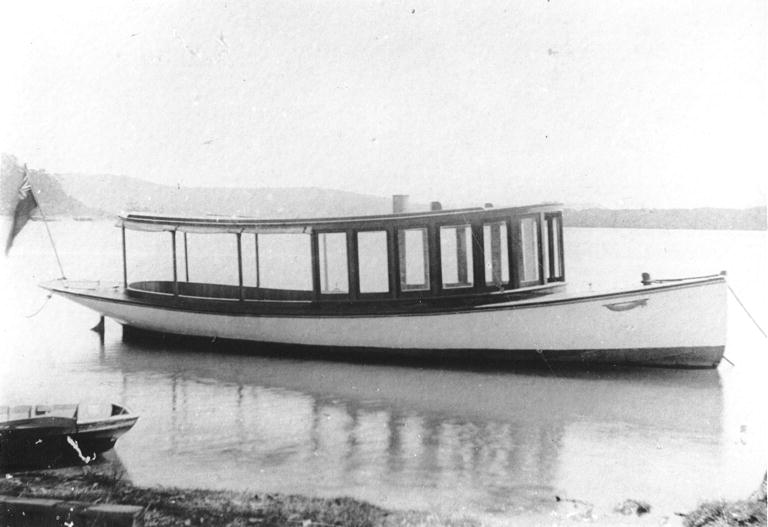
Disclaimer: These articles are not intended to provide medical advice, diagnosis or treatment. Views expressed here do not necessarily reflect those of Pittwater Online News or its staff.